Yosemite Valley. It’s hard to summarize the weight The Valley carried in my mind prior to this trip. For years, Yosemite has felt like a gaping hole in my otherwise fairly well rounded climbing resume. For years, schedules and fitness and partners have never quite lined up and I’ve told myself “next year” as I read about wild adventures on perfect granite. The “next years” seemed to compound, and for the last couple of years Yosemite has grown into an almost-mythical destination for me. If the valley is a once-in-a-decade trip, I found myself thinking, then I need once-in-a-decade fitness and once-in-a-decade goals for it to make sense going.
Of course, none of this is logical in any way. Yosemite receives 2-3 million visitors a year, has considerably more stable weather than many of the other places I’ve traveled to, and is less than a ten hour drive from Salt Lake. So, in early spring, I decided to put a stake in the ground. I picked a random week in October and texted some friends to let them know I would be in Yosemite then and they would be welcome to join for part or all of it.
Striking out on the initial camping reservations, I began the long process of tracking down campsites freed up from cancellations. A month or two out, I had campsites for a couple of days and my friend Hunter said he would join for the entire week. With the a partner and logistics coming together, I finally began to let myself get excited about the reality of doing some climbing in Yosemite.
In the end, none of my other friends were able to join for the entire week but Hunter’s friend Adam decided to join as he heads the field testing program at Black Diamond and could claim the week as a “work trip”. My friend Liam planned to come in from the Bay Area for the first weekend, giving use even numbers for at least the first few days.
Adam wanted to be able to sleep in his cushy built-out Sprinter, so Hunter and I loaded our stuff into the van and we left Salt Lake Friday afternoon.
Unfortunately the Forest Service had temporarily closed Tioga Pass due to an early-season snowstorm so we were stuck going the long way round. Unwilling to sacrifice a day of climbing, I strategically offered to take the last shift of driving and pushed on late into the night, getting to within a couple of hours from the valley before Adam asked if we could stop so everyone could get some actual sleep. We woke around sunrise and hit the road soon after.
I managed to contain my excitement well until we entered the park, but once through the gates I was like a restless puppy and came forwards to crouch between the driver and passenger seat so I could soak up the views. We rounded the corner to the Big Oak Flat Viewpoint and I got my first view of the valley below. Back in 2015 I had spent a couple of days in the valley around Christmas, but it felt different this time seeing the massive granite faces and knowing I was there to climb.
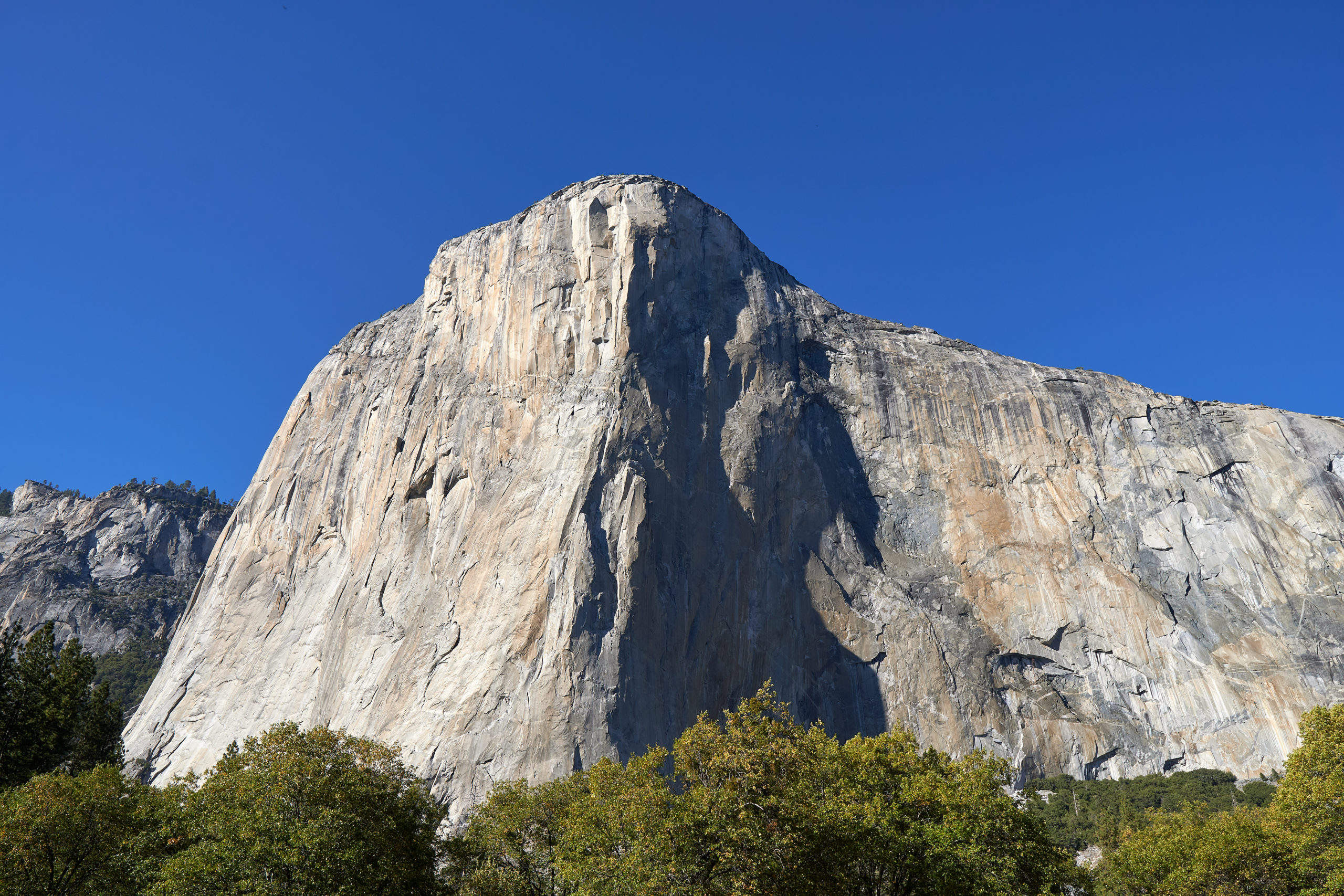
Liam and I had decided the climb Voyager would be a great first day climb; an approachable introduction to valley granite for me and a good test of multi-pitch systems for pebble-wrestling Liam. I hoped out of Adam’s van near the Bridalveil Falls parking lot, we sorted some gear, and started the approach up the Fifi Buttress. The hike up the hillside flew by as I chatted with Liam and soaked in the majestic trees, and soon enough we found ourselves traversing across the approach ledge and gearing up at the the base of the climb.
The pitches broke down perfectly for us to swing leads, with the odd pitches being harder on average and a bit “tradier” and the even pitches featuring an 5.11c “Boulder Problem” pitch. I took a moment to soak everything up beneath the first pitch, chalked up, and started up. The initial jitters were quickly replaced with a wave of relief as I made my way up the pitch. The friction on the granite felt reasonable, the movement, familiar. I wasn’t going to get completely shutdown this trip! I clipped the anchors at the top of the pitch and let out a whoop. The perfect rock had exceeded even my wildest expectations and I couldn’t wait for more.
The rest of the climb went smoothly. A definite highlight was managing to eek out an onsight of the pumpy “Incinerator” pitch. The crack in this perfect layback corner is just variable enough to prevent blindly placing gear from the layback, and I could feel all my late-summer mileage on Little Cottonwood granite paying off as I milked what friction I could from the granite to place gear.
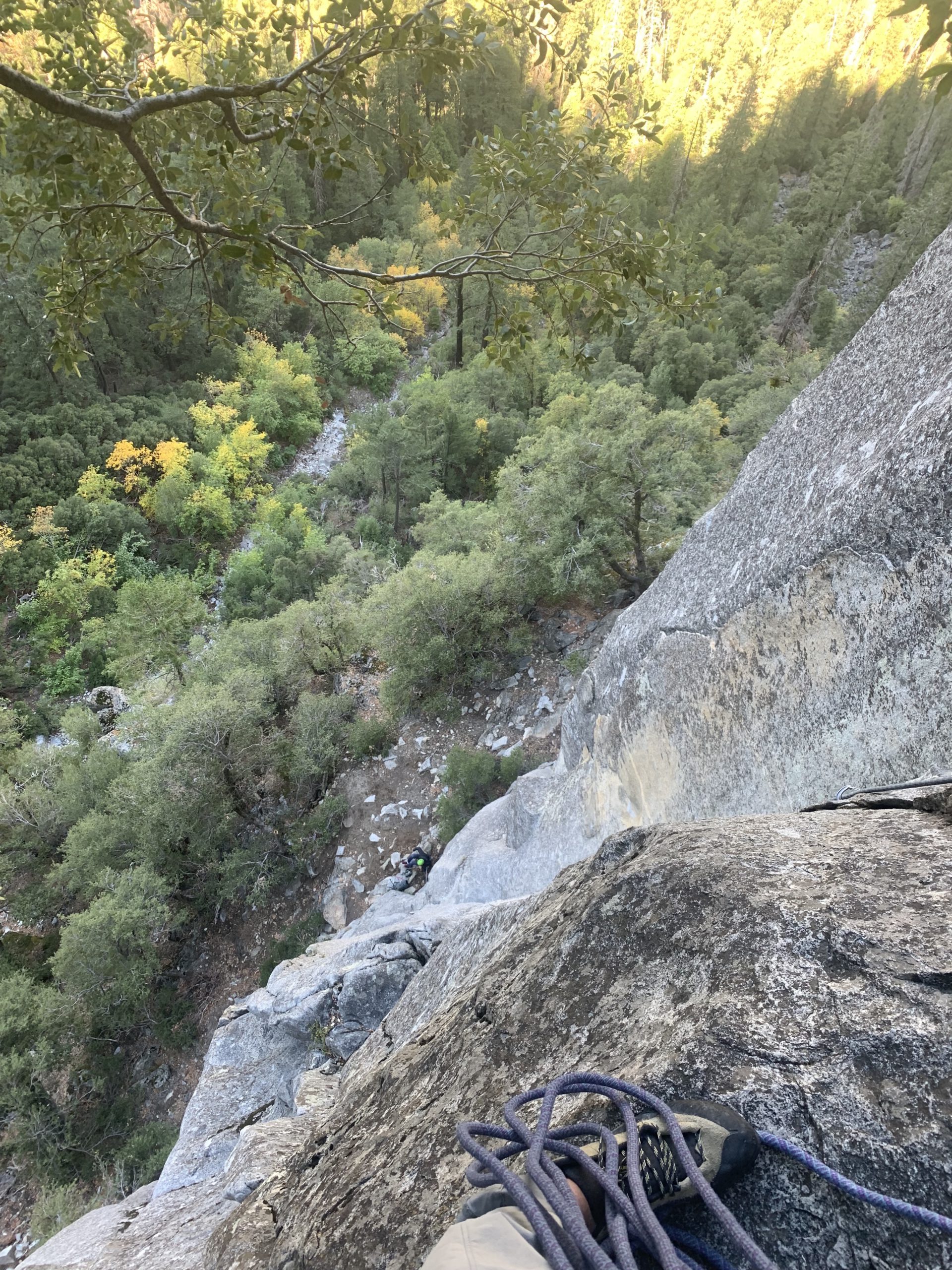

Liam crushed his pitches, looking great for someone on their 5th multi-pitch ever. We both took a fall to figure out the sequence through the “Boulder Problem”, but otherwise managed to make quick work of the other pitches. I did have to laugh as I watched Liam layback and double-gaston the perfect splitter hand-crack on the 7th pitch, but it worked for him and he joined me atop this final pitch gassed but all smiles.
The rappels down were uneventful, and we made it back to the car just in time to catch the sunset on El Cap. On the drive to camp, I could feel the pre-trip nerves fade away. Despite its rich history, the climbing in Yosemite wasn’t anything I couldn’t manage; I knew how to climb and I couldn’t wait for the week ahead.
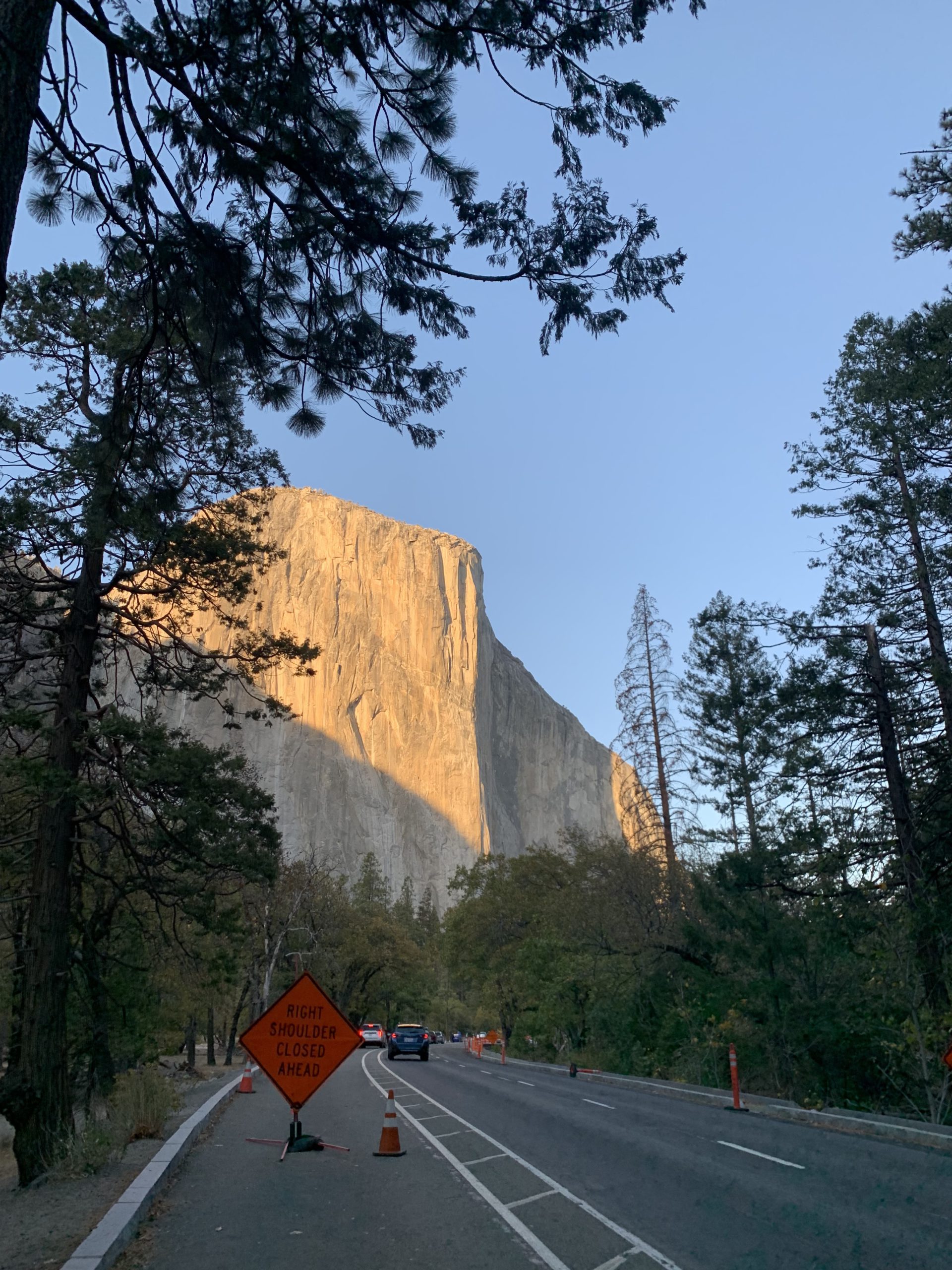
Back at camp we caught up with Adam and Hunter. Adam had injured his back a week before the trip and it was still quite sore so they had climbed the first few pitches of The Nose up to Sickle Ledge and then called it a day. Envious that they had gotten to climb on El Cap, I suggested climbing Freeblast the next day. Liam was down and Hunter and Adam were also interested so we decided to do a party climb.
Adam’s work-trip responsibilities reared their ugly head the next morning and he spent several hours getting feedback on some prototype big wall gear from a field tester while I did my best to stay zen and not gnaw my arm off. Finally around 10am we headed to El Cap Meadow.
Getting to the meadow I couldn’t believe how big El Cap looked towering above us. Even from this closer vantage point it seemed surreal, like a movie backdrop or a phone wallpaper, not something I would actually be climbing shortly. My disbelief only grew as we did the the short, ten minute approach to the base. Where was the ticket booth? Or the theme-park turnstile? When was some sort of security going to come up and ask for my climbing resume and turn me around? It just didn’t seem possible that a piece of rock that loomed so large both in my mind and in the history of climbing should be so readily and freely accessible.
And then we were at the base of the Salathé. I couldn’t help but run my hands along the rock, reassuring myself it was real. A group was getting ready at the base with the intention of only doing the first pitch, but other than that there were no other parties in sight. I couldn’t believe my luck. The group ahead of us made quick work of the first pitch and around 11:30am it was our chance to start up.
The first 30 feet were mellow scrambling which gave me a chance to focus and find some proper perspective; I was just out for a great day of climbing on great rock. After the introductory ramble, the rock steepened and the remainder of the pitch was made up of a pair of cracks, providing great jams and good gear. I arrived at the anchors thrilled at how reasonable the climbing had felt.
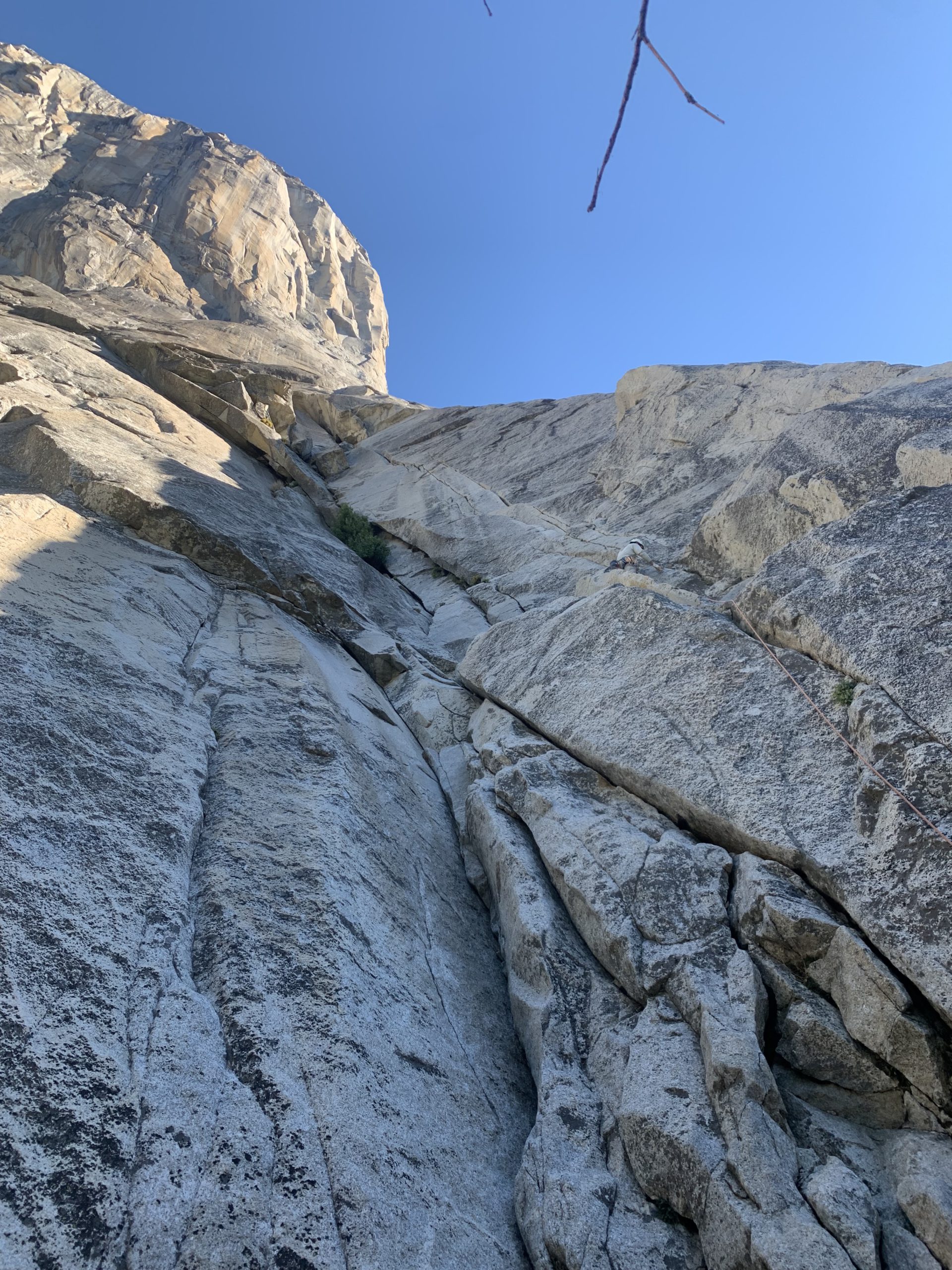
The next pitch began with a fun wide crack that quickly deposited me at the base of the roof, the first crux of the day. I clipped the bolt, wormed in a semi-inspiring totem into one of the handholds at the beginning of the roof, and began to tiptoe out onto the small footholds. The roof featured two fixed nuts which thankfully looked to be in good shape. With those clipped I chalked up repeatedly, pondering how to exit the roof. Eventually I committed to a sequence and slapped my hand blindly over the roof, finding only smooth granite. I slapped again and this time found a bomber pin scar for my fingers. Letting out a whoop, I pulled over the roof and worked my way to the anchors, psyched to have managed the first crux pitch with no falls.
Liam took the next pitch, a techy 5.10 crack. He kept the send train rolling and styled the insecure stemming and liebacking, climbing confidently for someone with so little trad experience.
The next pitch was the groove pitch. This difficult-to-protect, pin-scarred groove is the topic of much discussion on the Freeblast Mountain Project page, and I was uncertain what to expect. The climbing through the grove was more secure than I expected, but the pin scars definitely made for tricky gear and the climbing was slow. I reached the bulge and got a good cam in, but as I prepared to pull through the bulge my feet kicked out my previous piece which spun down the rope, sliding into the piece below that. To my dismay, this impact proved enough to dislodge the second piece, and I wormed my fingerlocks deeper as I watched the two pieces come to a stop a good distance below me.
A bit shaken, I managed to find another good placement at the bulge, and then committed to the last few moves to reach the first bolt and the start of the slab section. The slab was blank and slick, but I trusted my feet (and tried not to think about Alex Honnold up here without a rope) and managed to eek through the traverse left and then back right. Standing in a little dish, I could see the final few bolts to the anchor straight above me, but I couldn’t figure out which way to climb through the smooth looking section above the dish. After some contemplation and a few false starts I decided to try to the left of the bolt. I made it a couple of feet but eventually the smears ran out and I felt myself peel off the wall. Disappointed to lose the onsight, I pulled back onto the dish and took a moment to compose myself before starting up to the right of the bolt. The climbing felt extremely insecure, but this time the smears continued and, after a couple of feet, edges began to reappear and I soon arrived at the anchors.
The next pitch started with more delicate climbing, this time working up a faint ramp through some bolts. The bolts deposited me at a small overlap with a upwards-driven piton as the only pro. The piton appeared to be in good shape, but doubt began to creep in as as my chest, then my knees, then my feet made their way passed the piton. Pausing on some small crystalline edges, I eyed up the next good bolt just a couple of moves out of reach. The webbing hanging off the piton suddenly seemed like a very appealing foothold as I envisioned the piton popping and the subsequent cheese-grating fall down the slab. But I knew I would regret it if I cheated myself of the experience, so I stabbed my foot out to a slippery edge instead, and pulled for the next good crimp. The foot held, and I scampered up the final easy ramp to the belay.
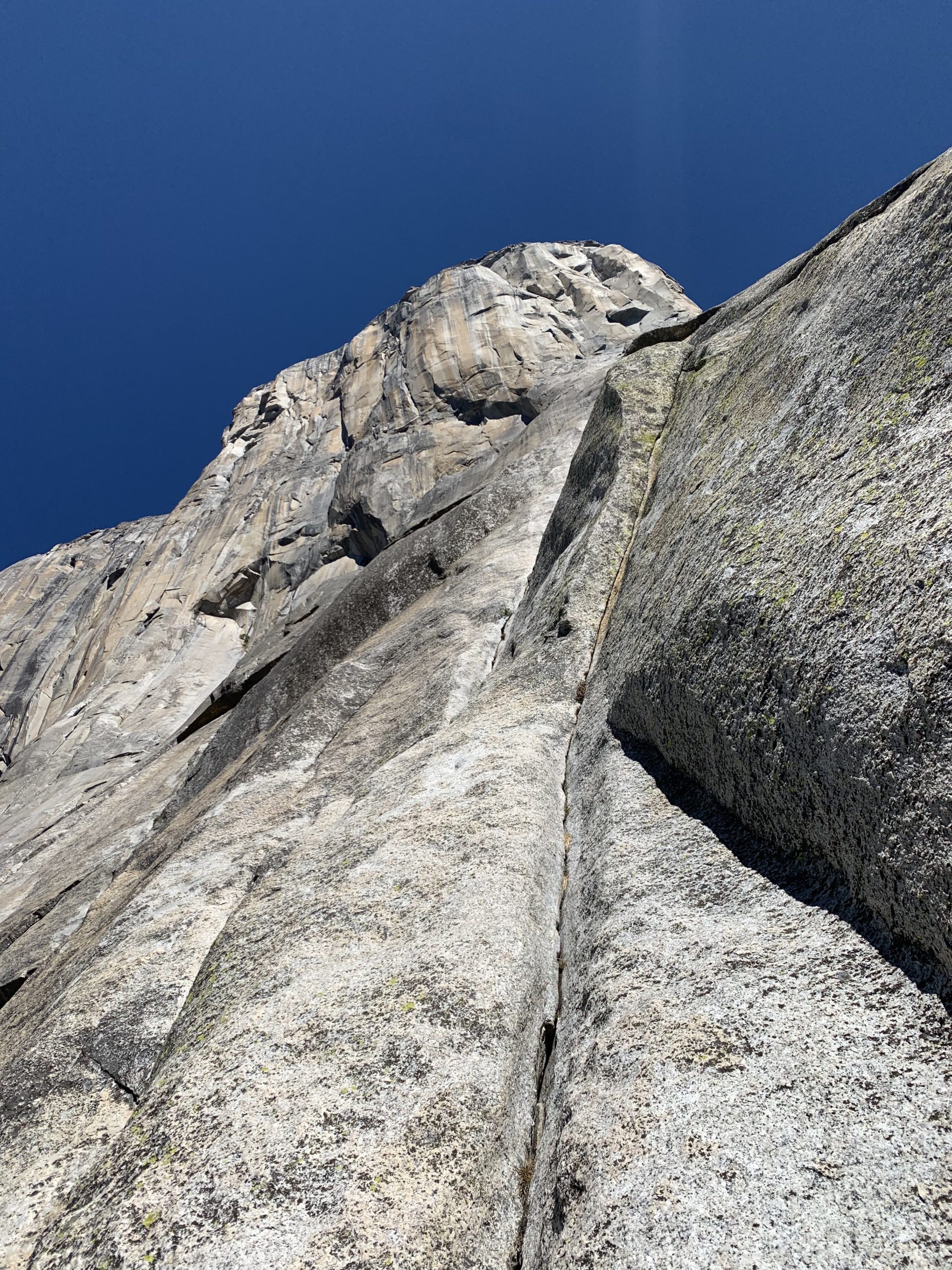
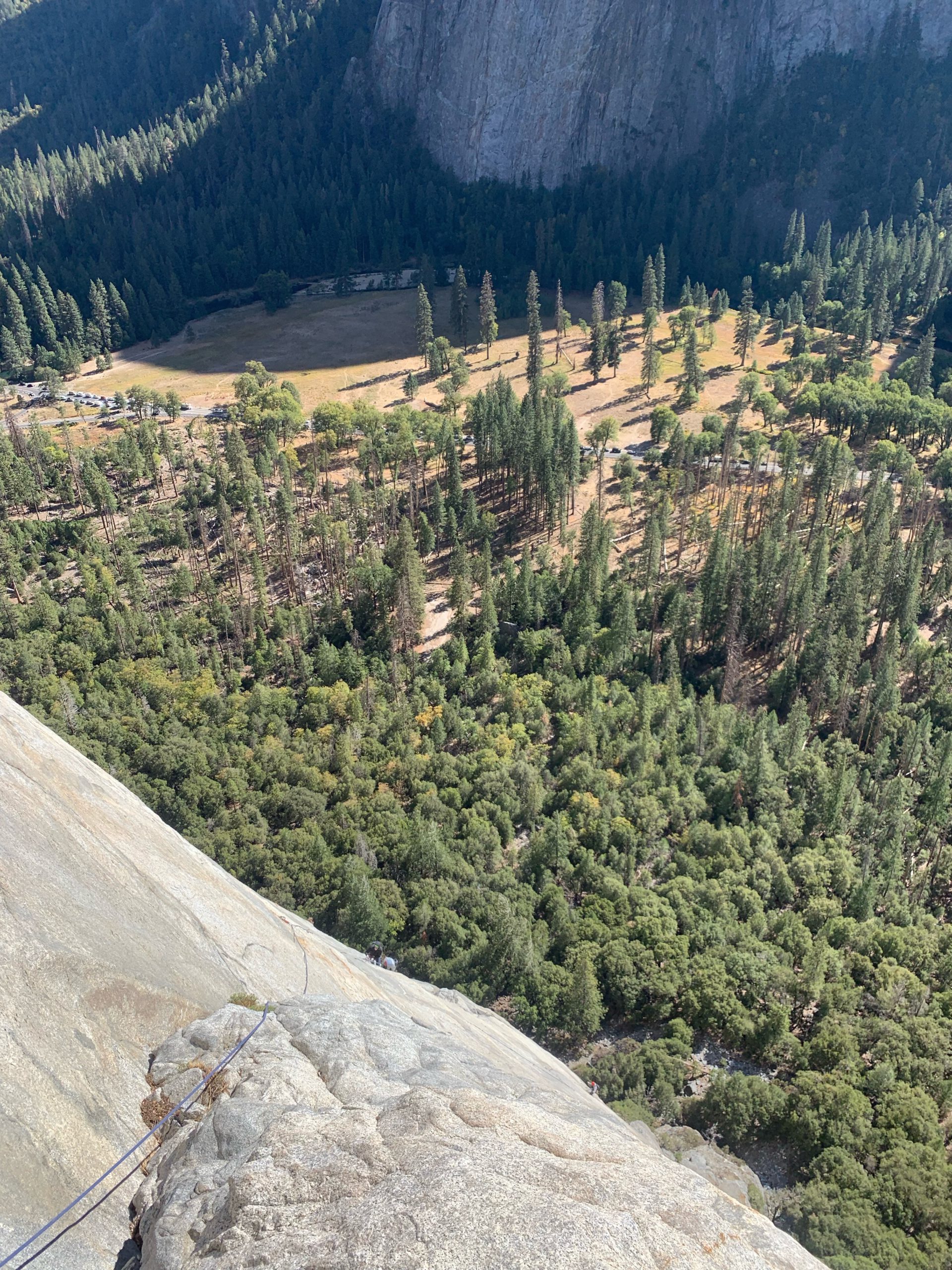
With all the 5.11 pitches behind us, Liam took the next pitch: a fun, if not slightly dirty, corner system to the base of The Half Dollar. The Half Dollar is the first wide pitch on the Salathé and the last hard pitch on the Freeblast. From the anchor, I couldn’t see much of the pitch, but I was excited to sample a bit of Yosemite wide climbing. The traverse along the initial roof section went smoothly, and I promptly found myself looking up at the bombay corner that defines the pitch. The corner itself looked reasonable, but the slippery entrance was perplexing. It took several retreats to the good holds at the end of the roof, but eventually I figured out the body positioning. With a few moves of paradoxically physical yet insecure funk I was able to worm my way into the corner system. The rest of the pitch was physical, but wonderfully secure in contrast to the rest of the day’s climbing.
From there one long pitch of 5.7 took us to Mammoth Terraces and the top of the Freeblast. The easy climbing felt like a victory lap after the demanding earlier pitches, but I couldn’t help but think about the accident a few years ago where two very experienced climbers died simul-climbing this moderate terrain, a potent reminder not to get complacent about safety systems.
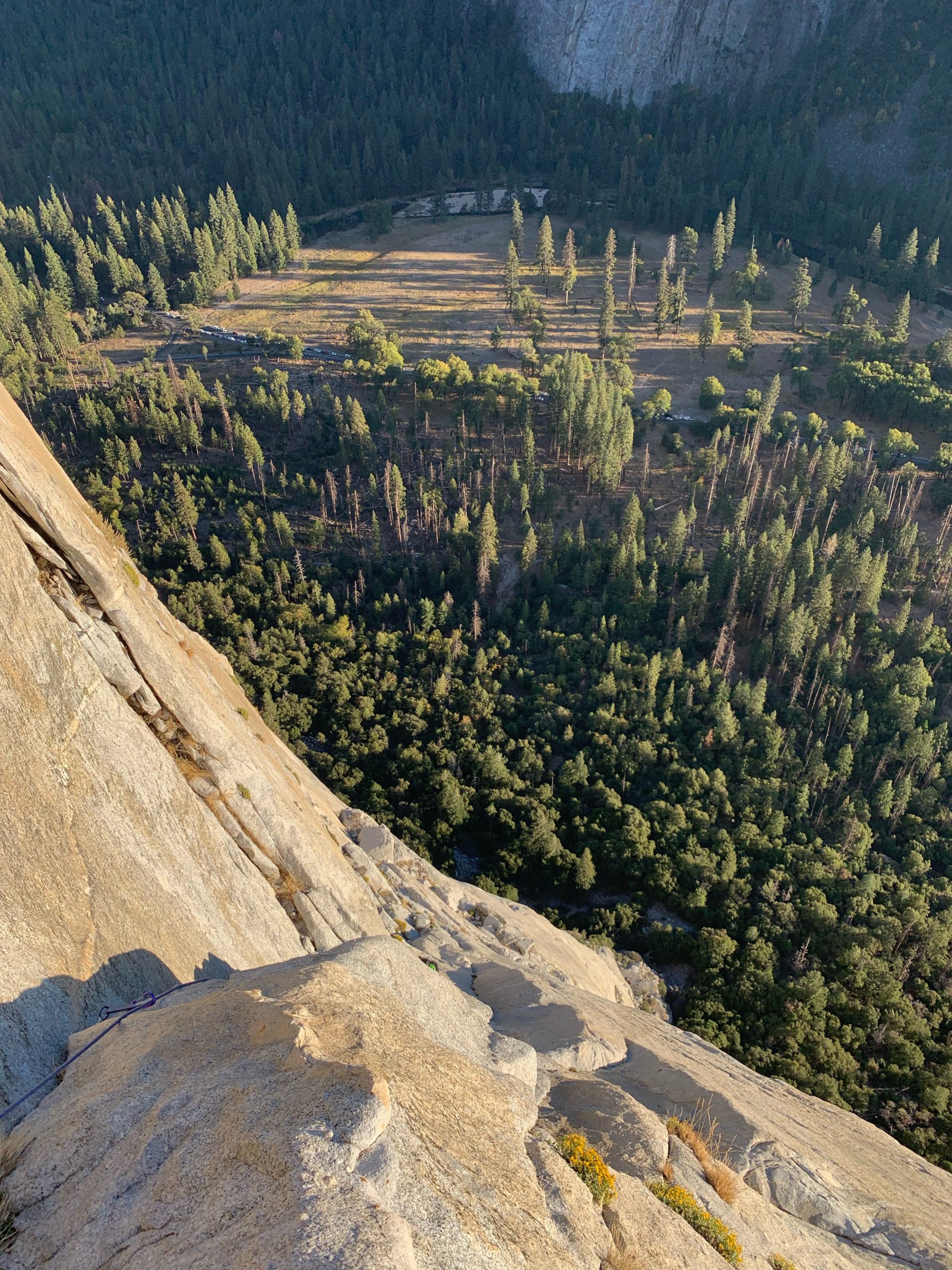
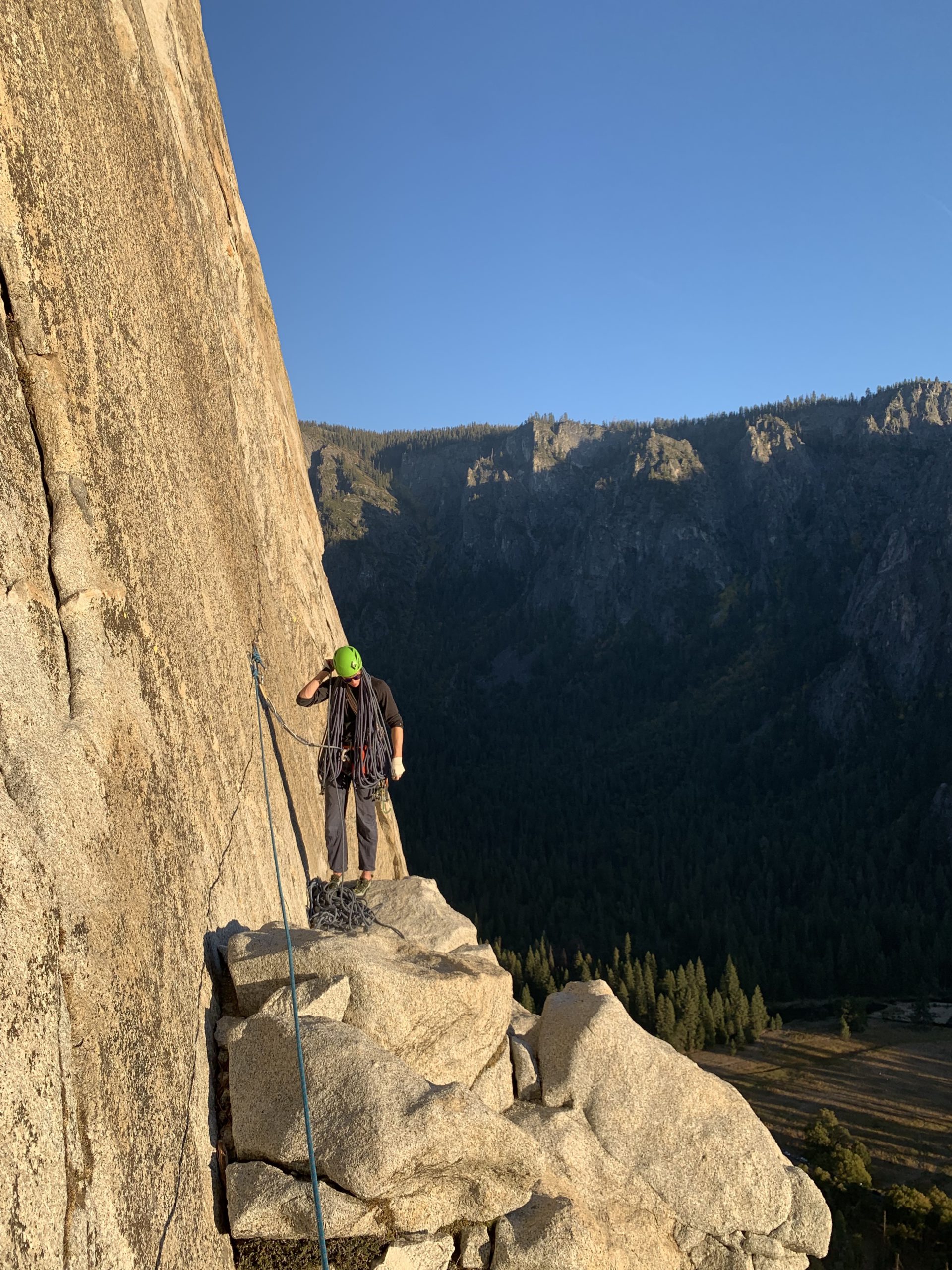
Liam and I arrived at Mammoth Terraces right as the golden hour of sunset began. As we savored the spacious ledge, enjoying some food and water, a climber rappelled in from above where she had been working a free-pitch on the Muir Wall. A YOSAR member and obvious crusher, she moved around and existed on the wall with immense comfort. It definitely made me want to come back and spend some more time on El Cap.
With the sun starting to set, we hopped on the fix line down to Heart Ledges and from there it was a few more rappels down some more fixed lines back to the base of El Cap. Despite my one slip on the crux slab pitch, I could not have asked for a more perfect day. In just seven hours El Cap had gone from feeling like a mythical mountain to a tangible piece of rock that I’m excited to spend more time on in years to come. The climbing had been demanding but manageable, and I was proud of myself for committing and giving every pitch my best.
We awoke the next morning to some cool weather. Liam had to get back to San Francisco and Adam’s back was not doing well after the Freeblast so Hunter and I were free to climb together. We were both feeling a little sore after the past two days, but stoke was still high so we decided to head up Astroman, with the intention of doing the first five pitches, often referred to as Astroboy.
It took us a bit to find the correct approach, but soon enough we were at the base. By this point, the wind was whipping and clouds were foiling our plan of climbing in the sun. Hunter led the first pitch to the base of the 5.10a layback crack. I led the layback crack, struggling up it with numb fingers and toes. I built a belay beneath the 5.11c Boulder Problem pitch, graciously signing Hunter up for the harder variation. Stoke was considerably lower at this point and Hunter quickly resorted to aid climbing to get up to the base of the Enduro corner. I managed to sneak through the opening section, the polished rock feeling horrendously slippery under my plastic-like fingertips, but resorted to pulling on gear to the anchor as a wave of screaming barfies hit me.
We hung at the anchor looking up at the perfect splitter above us. On one hand, the Enduro Corner is a historic pitch and just begs to be climbed. On the other hand, the back of the corner was already in the shade and the whipping wind and numb hands made the pitch feel very, very intimidating. Our deliberations were cut short when we began to feel snowflakes. The weather gods had decided. We weren’t weenies for bailing, we had an excuse. We happily retreated to our jackets at the base. We dubbed our variation Astrotoddler, but even that may have been giving ourselves too much credit.
Our desire to climb began to thaw out as we sat, protected from the wind and wrapped in warm puffies. We decided to head across the valley to get on Mr. Natural on Glacier Point. The Moutain Project description seemed a bit over the top: “offers more perfect fingerlocks than many climbers will encounter in their life times”, but Hunter had climbed it on a previous trip and assured me those claims of greatness were well deserved.
A quick bike ride brought us to the base of Glacier Point, and a quick five minute approach deposited us underneath Mr. Natural. Hunter graciously offered me the lead so I racked up and headed up the easy 5th class gully we used to access the start of the climb. Hunter joined me at the belay and I set off up Mr. Natural. The start of the pitch involved some heads-up traversing, but once I was in the crack it was 160 feet of almost entirely spitter 0.3 finger crack. The angle of the rock was absolutely perfect. Any steeper and the climb would be 5.13. Any slabbier and the splitter crack would feel like an accessory on a mellow low-angle romp. As it was, the slightly less than vertical granite provided just enough feet to take some of the weight, while perfect fingerlocks did the rest. At the end the crack pinched down to tips and then seamed out completely, requiring a couple tenuous slab moves to the anchor. The rock felt bitterly cold in the shade, but even with numb and bleeding tips I couldn’t help smiling from ear to ear.

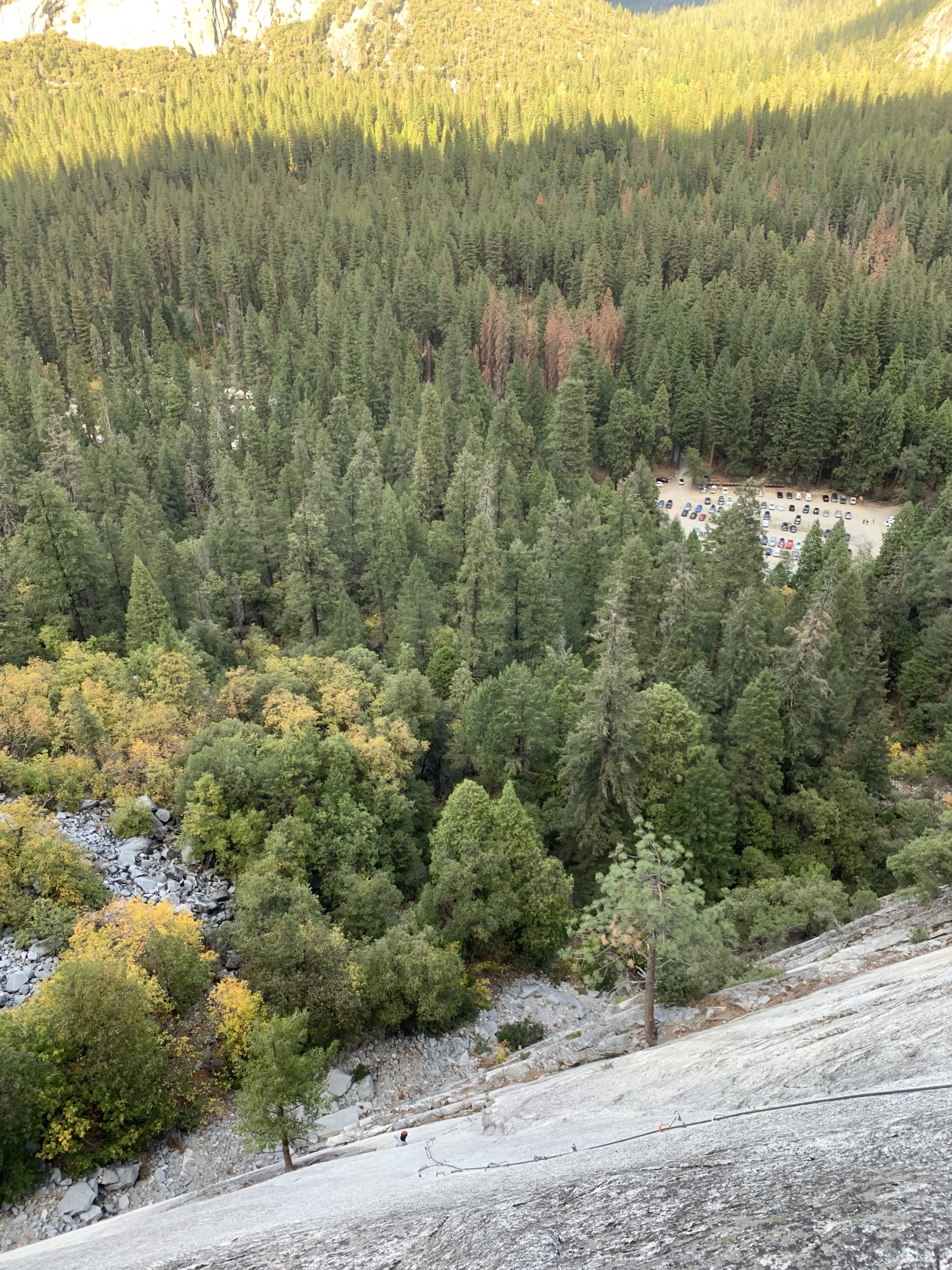
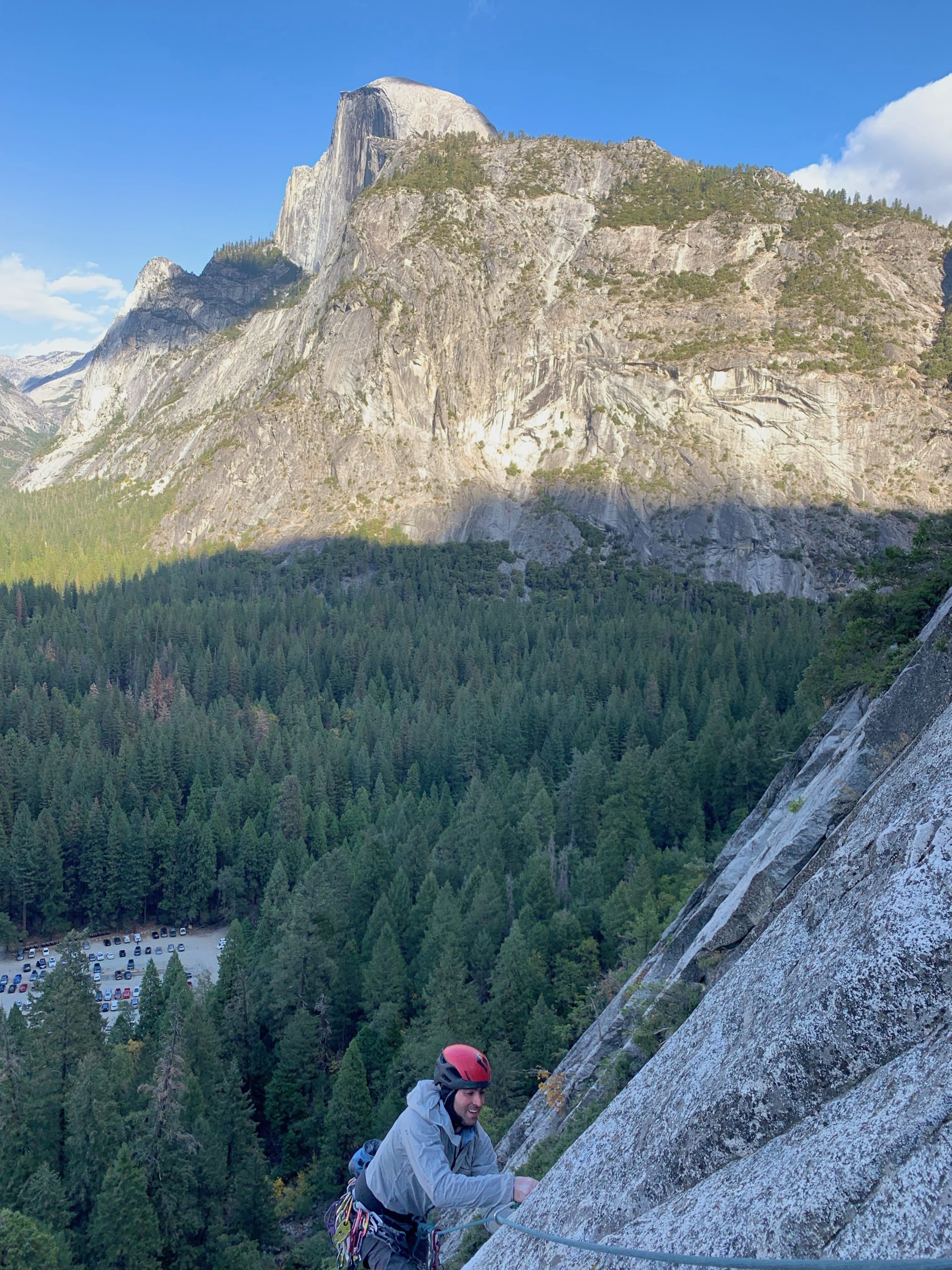
Adam’s back was still a mess the next day so Hunter and I again had free reign to climb as a party of two. Deciding our bleeding and swollen cuticles could handle a bit more abuse, we decided to head up the all-time classic, Serenity-Sons.
To our joy, we arrived at the base with only a single party on route. I took the first pitch, and carefully navigated my way up the pin-scarred start and into the enjoyable jamming above. Now above the trees, I felt a strong surge of wind. Unfortunately, that gust was no outlier and by the time Hunter joined me at the top of the first pitch I was fully shivering. Hunter took the next pitch and I tried to think warm thoughts as I hung from the belay. I momentarily forgot about the cold as I followed the pitch, enjoying the delicate crack switch half way up.
We did a quick transition and I started up the crux third pitch. I once again found myself jamming numb, slippery fingers, but luckily managed to keep it together through some foot slips and top out the thin crux. Unable to think in the strong wind and with the group ahead of us dealing with a mess of ropes at the anchor, I opted to head up to the ledge system beneath Sons of Yesterday. I was delighted to find some small bushes, and took shelter behind them as I belayed Hunter up.
He joined me behind the bush and we discussed our next moves. It felt lame to bail on yet another climb, but with winds probably gusting above 30 mph and wind-chill solidly in the 30’s, the idea of continuing upwards seemed unpleasant. We hung out in our hideaway for close to an hour, soaking up the sun, before motivating to re-enter the wind and descend to the ground.
As soon as we got back below the trees, the wind instantly disappeared, reaffirming that there was warm climbing to be found. We decided to head over to the base of El Cap and do some cragging. We ran a quick lap up Moby Dick and then proceeded to get completely shutdown on the opening squeeze of Ahab. Ahab may give Regge Pole a run for it’s money as the hardest 5.10 I’ve every tried. The idea of Royal Robbins soloing it in tennis shoes is both mind-blowing and utterly inspiring.
Adam’s back was still doing poorly when we returned to camp that evening. While I was sympathetic, I couldn’t help feel a little liberated that Hunter and I would be free to plan the rest of the week accordingly. Hunter and I had fantasized about attempting Nose in a day (NIAD), but the NIAD was one of Adam’s lifetime goals and it had been unclear how it would have felt to leave him partner-less while we tried to check it off. But with Adam out of commission, my qualms about going for NIAD disappeared. I raised the idea with Hunter and he was down.
We decided to take the next day off as a much needed rest day, and attempt it on Friday. The next morning we rode our bikes to El Cap Meadow to begin working out the logistics. It was my first time all trip getting a chance to slow down, and I spent most of the morning just staring at the massive hunk of rock in front of me.

Even from the meadow, El Cap looms tall enough to cause some serious foreshortening. Parties near the bottom appear ant-like, but are at least large enough to be easily visible with the naked eye. It is not until you spot climbers higher up, barely visible without binoculars, that you realize just how massive El Cap really is. Below are some climbers on the wall, showing this phenomenon. Clockwise from top left: A group finishing up the last slab pitch of Freeblast with the Half Dollar above, some wall climbers partway up the stovlegs on the Nose, a group through the Lynn Hill Traverse and working towards Camp IV, and a party above the Changing Corners and about to head up towards the Wild Stance.
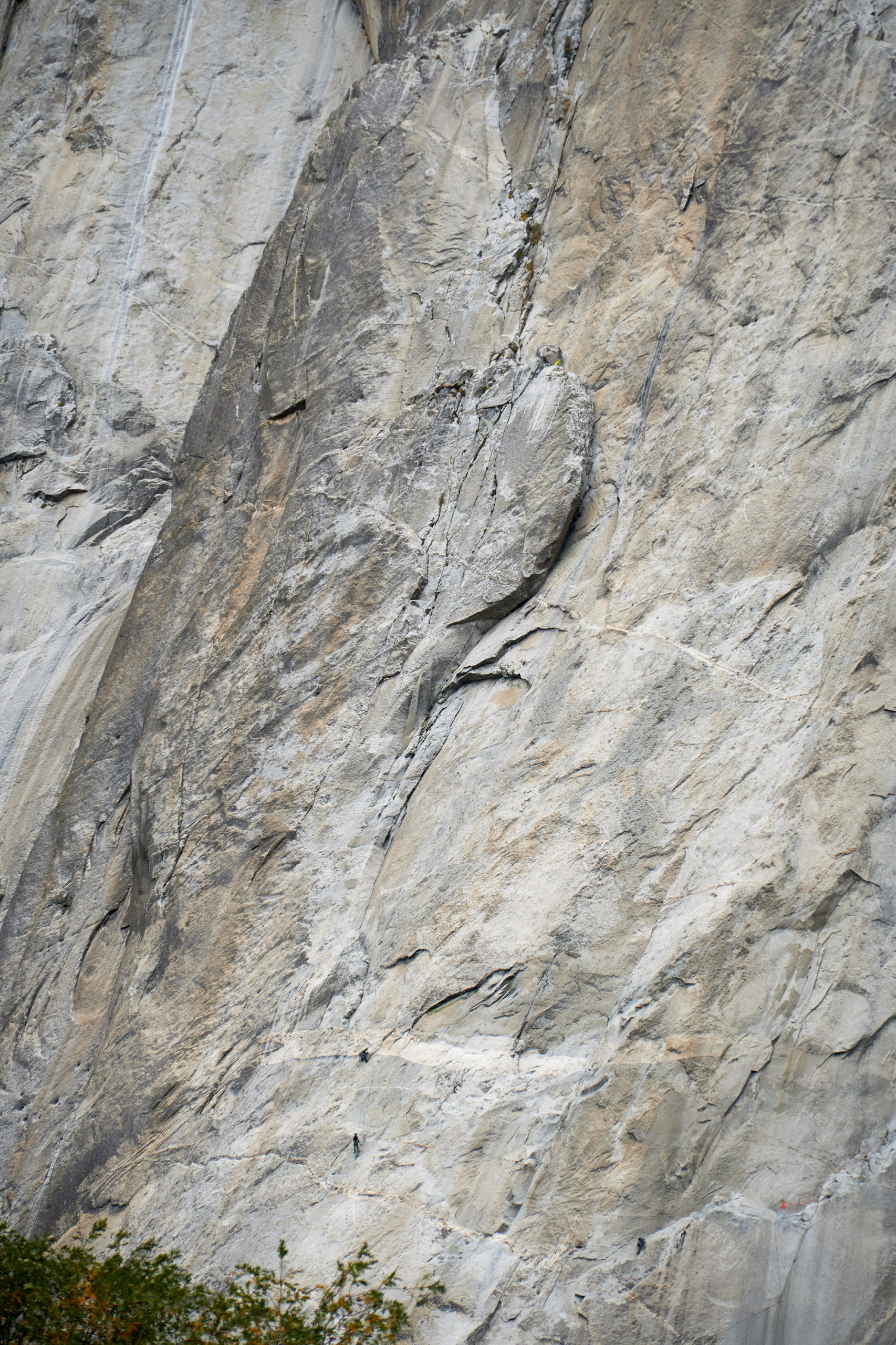
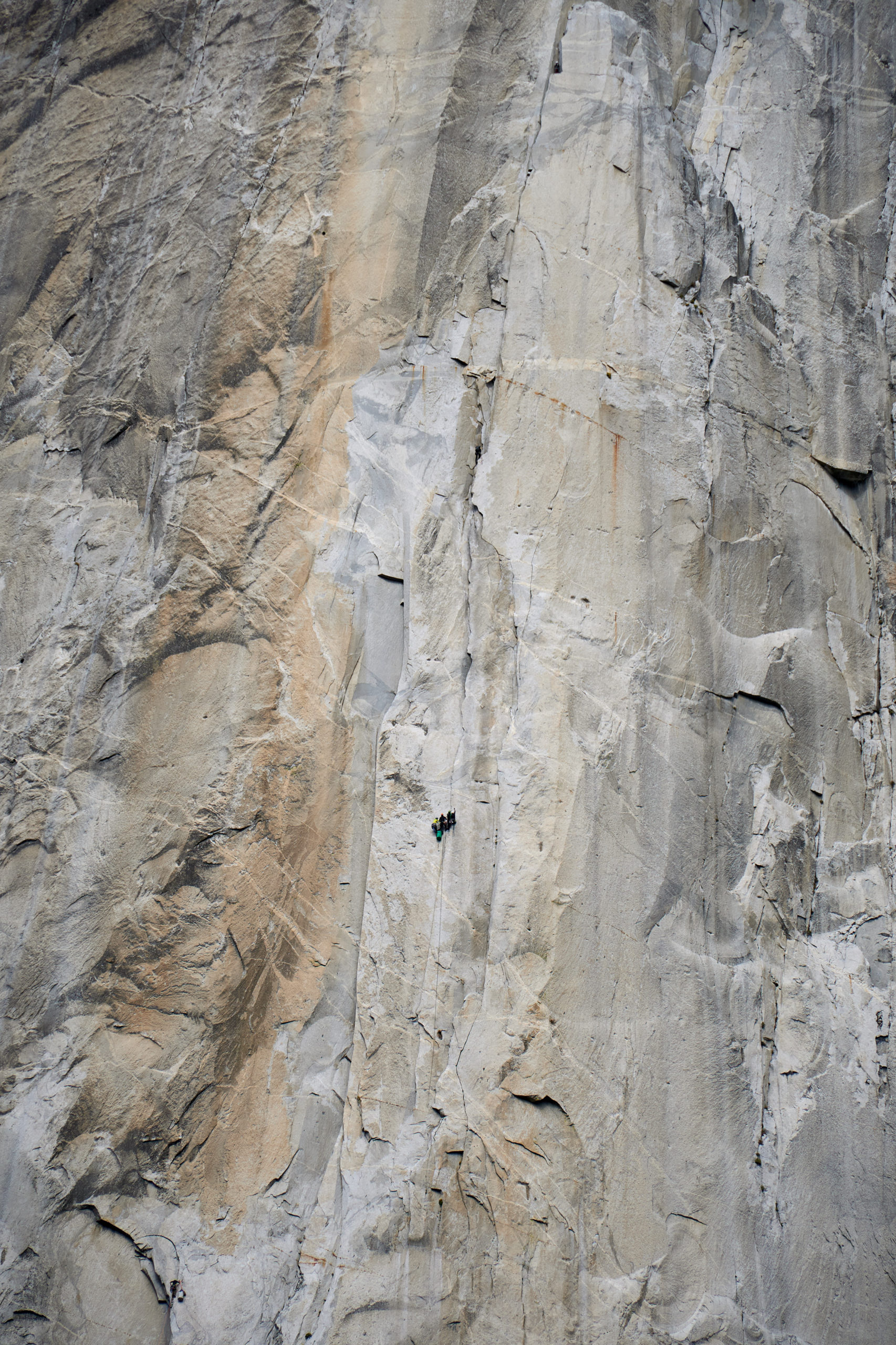
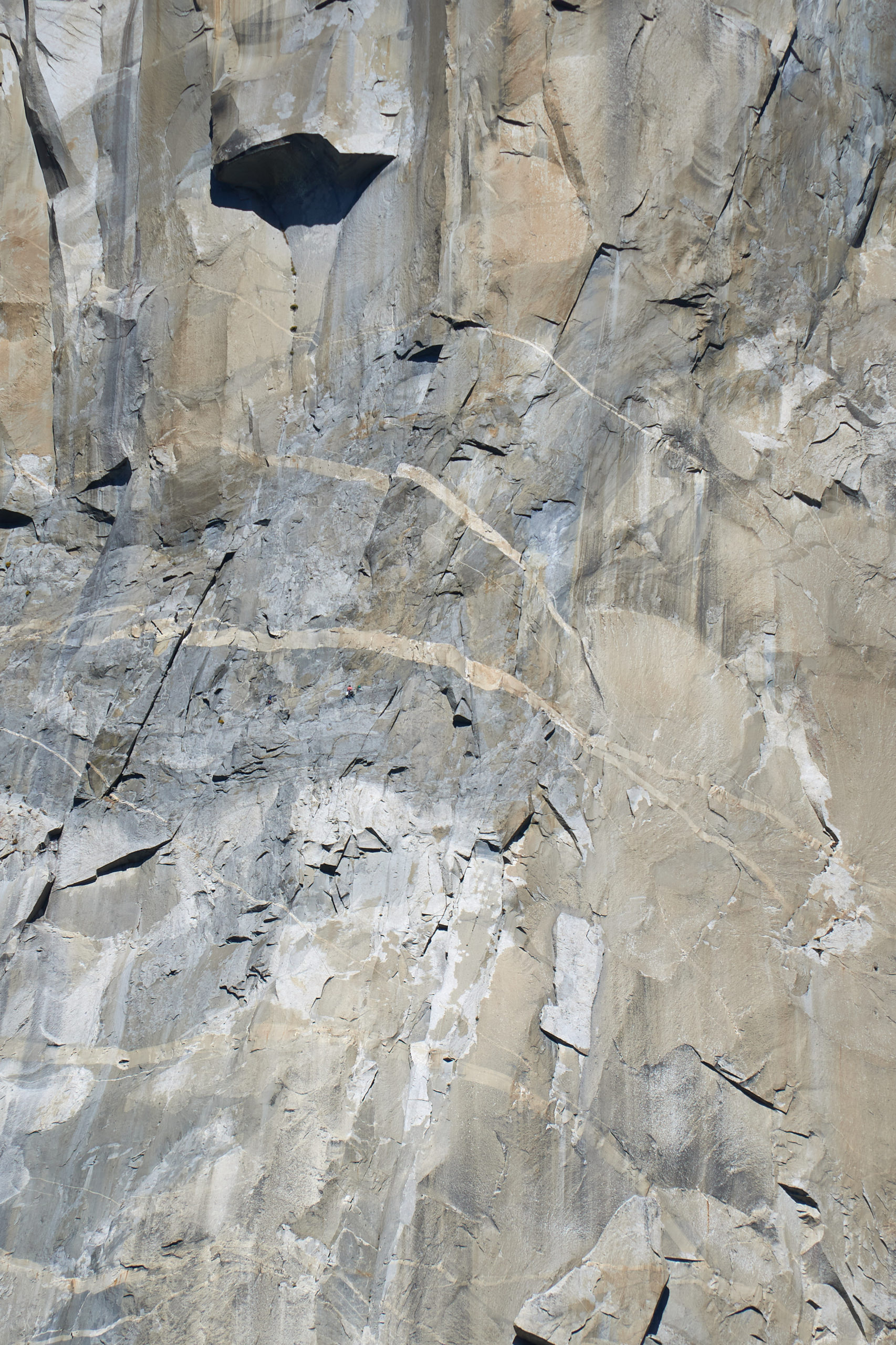
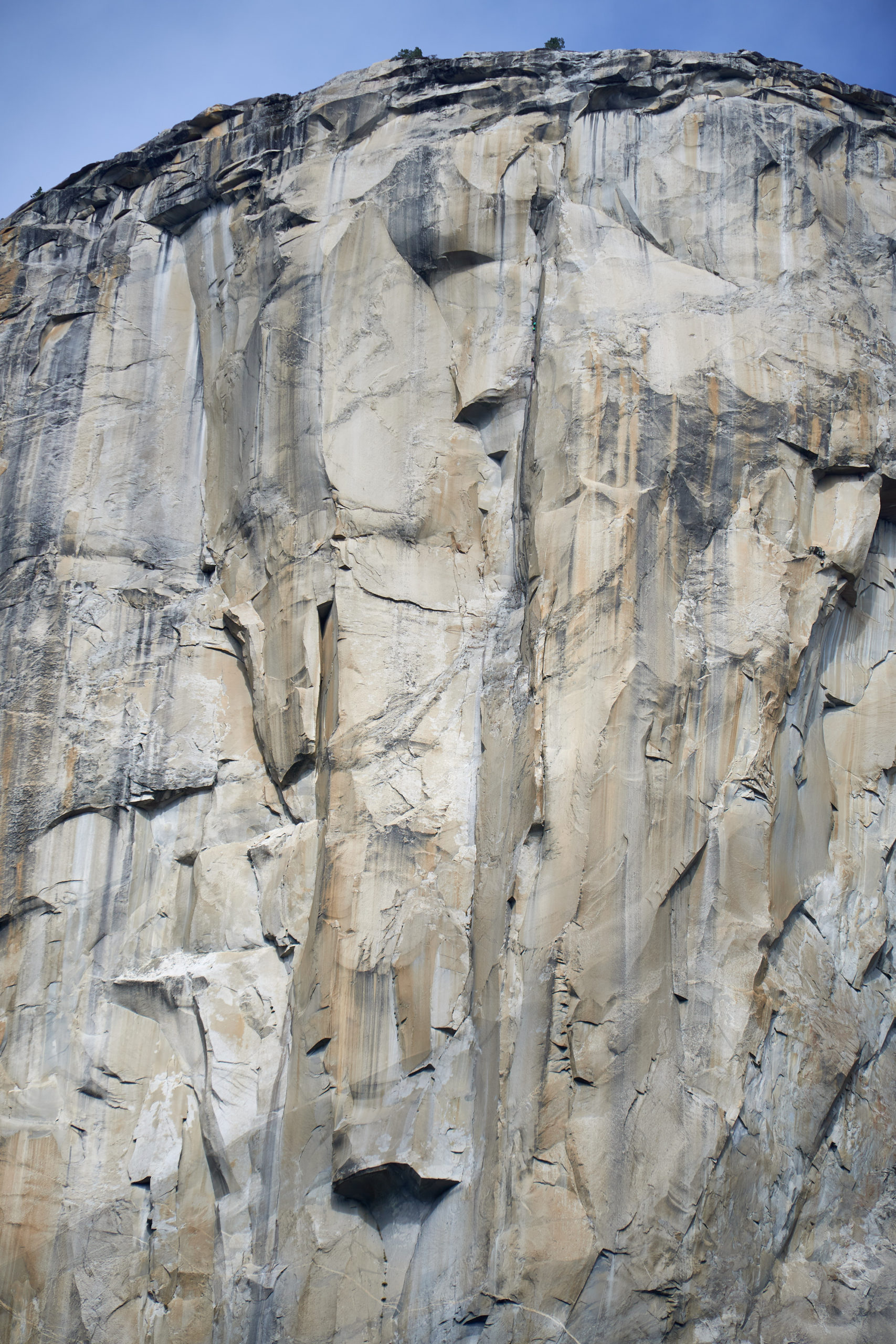
Below is the location of these four photos (note: the climbers are missing from the Freeblast slabs in this overview photo as it was taken at a different time).
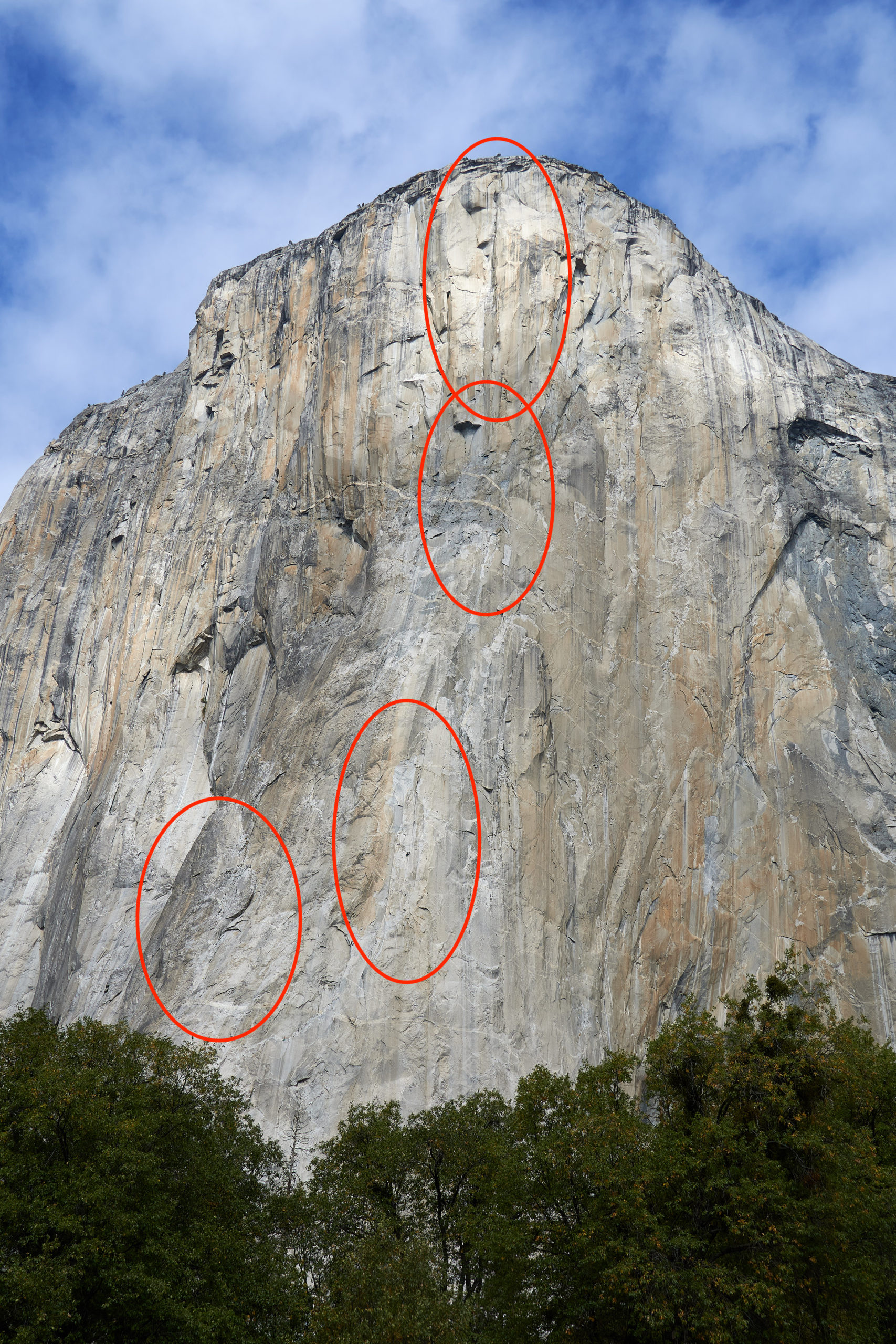
Needless to say, it’s an intimidating piece of rock to look up at and know you are going to try to climb in a single day.
Here is a nice annotated picture of the route, courtesy of the one and only Steph Abegg.
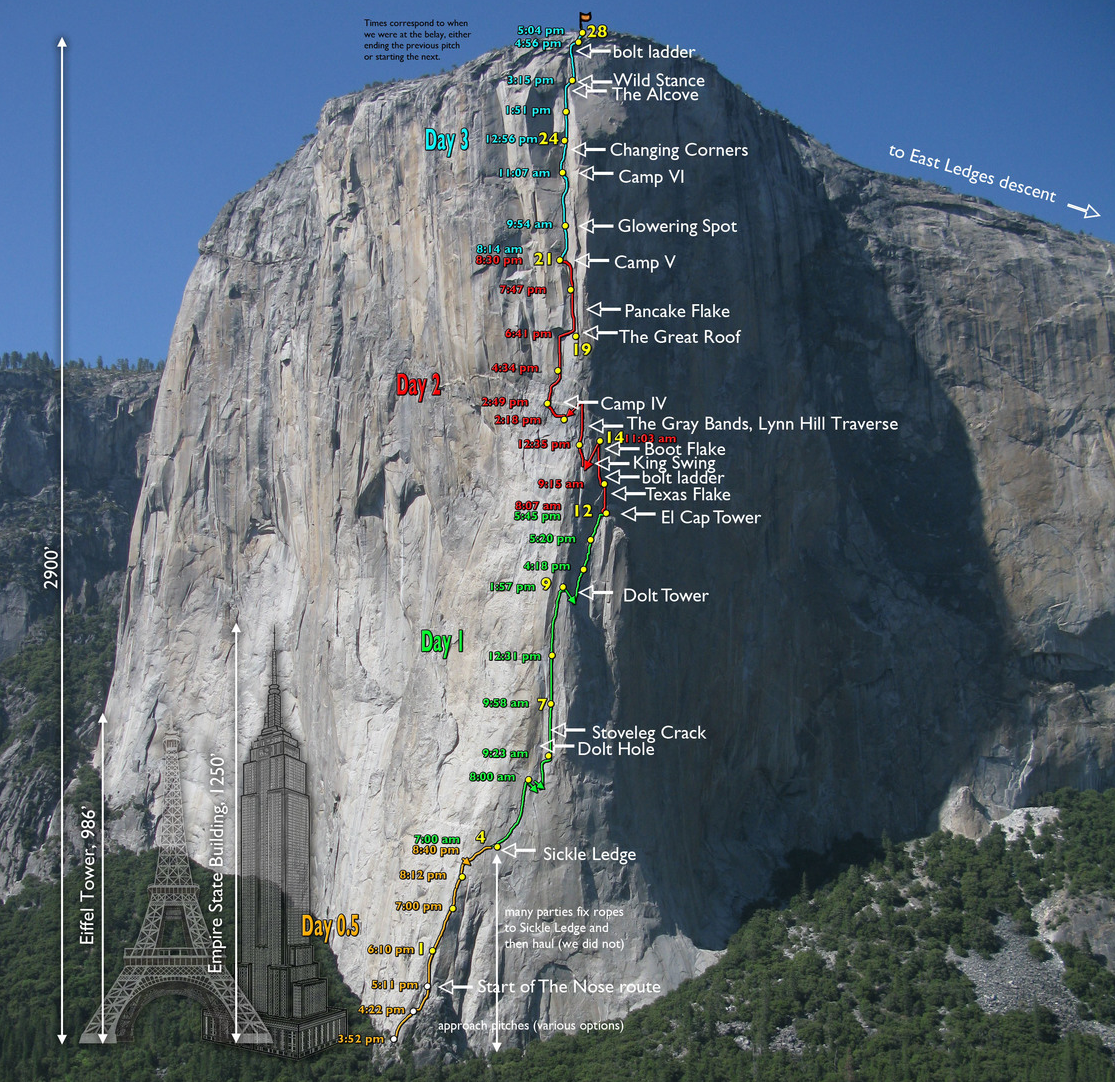
Hunter and I got about discussing strategy. Hunter had done a run to Dolt Tower on an earlier trip and a lap to Sickle at the start of this trip. Having lead the notoriously polished and tricky opening pitches both times, he was psyched for a break, so I agreed to lead the first block. We were unsure how to best get through the traverses into the Stovelegs and every report we read seemed to do it differently. In the end, we decided to transition after the first pendulum off of Sickle. Hunter would lead to El Cap tower where I would take over to the base of the Great Roof. Hunter’s second block would be to Camp VI and I would take us to the top. Doing it in five blocks seemed like a nice way to switch up the roles fairly frequently without greatly sacrificing efficiency. The blocks also meant that we each got some of the iconic features: Stovelegs, Great Roof, and Pancake Flake for Hunter, Texas Flake, King Swing, and Changing Corners for me.
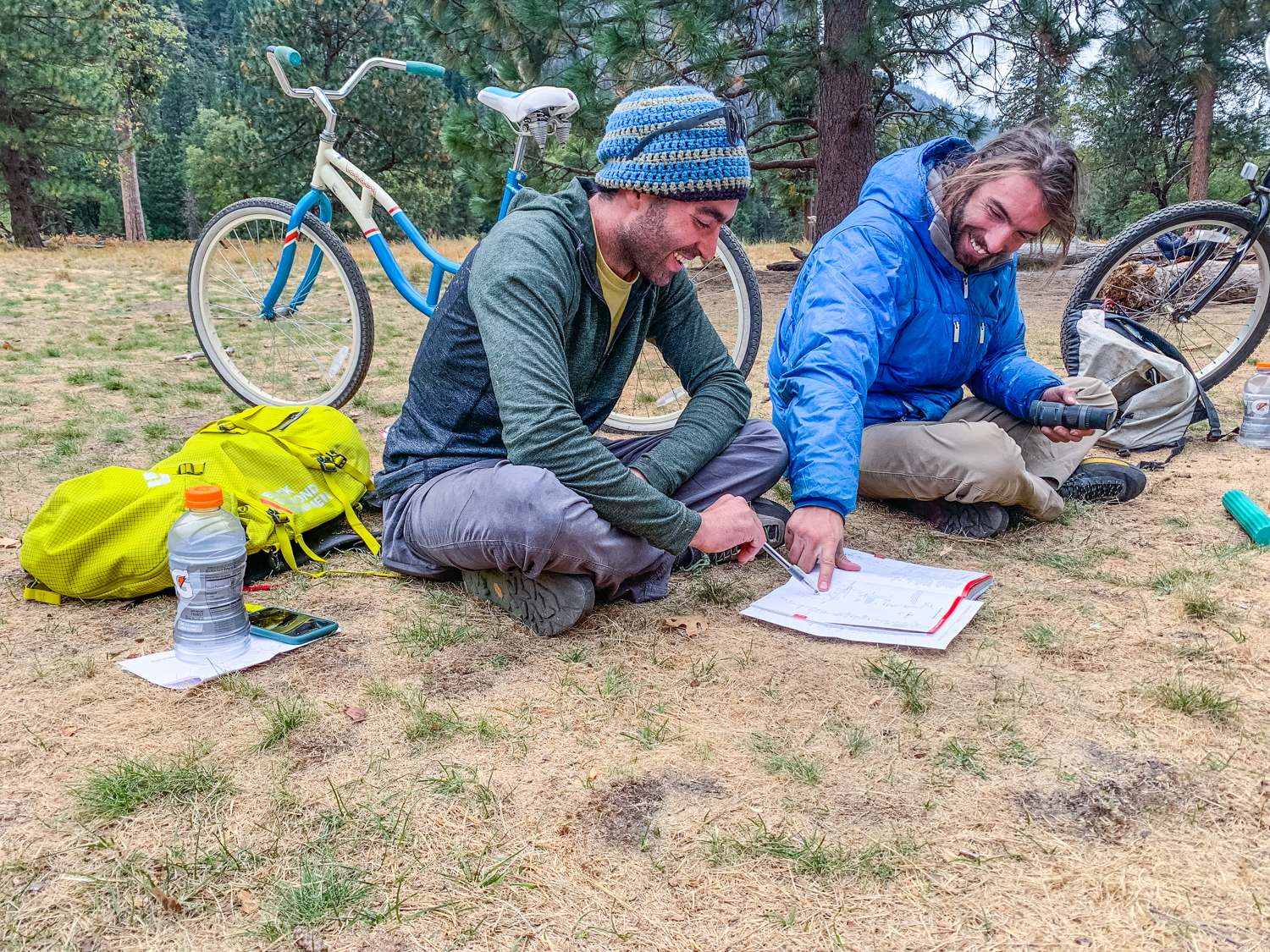
Satisfied with our game plan we headed back to camp to sort gear and for an early dinner. For gear we ended up bringing:
* 70m lead line
* 20m tag line
* Assorted collection of small and medium offset nuts
* Single 0 and 0.1
* Doubles from 0.2 to 4
* Singles of offsets from 0.1/0.2 to 0.5/0.75
* A #2 Link Cam
* Two medium cam hooks
* ~15 slings
* 6 lockers
We each climbed with a microtraxion and grigri, the leader climbed with a pair of Black Diamon aiders and the follower used a pair of Metolious Easy Aiders. We brought a 30 liter pack which the follower jugged with, and started the day with 5.5 liters of water.
While sorting gear I suddenly realized I wasn’t sure I knew how to do a lower out, a maneuver needed by the follower to lower diagonally down from a pendulum to avoid a large swing. Luckily Adam had installed bolts on the inside of his van; the perfect classroom for a last minute lesson on big wall technique.

Satisfied with our preparation, we enjoyed a large pasta dinner and then headed to the tents for an early bedtime. My brain is notoriously bad at shutting off the night before a big adventure and unfortunately this night was no different. I tossed and turned as I watched the clock tick to 10pm, then midnight, then 2am. Luckily I managed to dose off for an hour or two, and was awoken at 4am to my alarm.
Adam kindly drove us to the meadow where we double checked we had all of our stuff and headed off into the woods towards El Cap. In an attempt to go for the rare sit-start onsight (not out of laziness) I had failed to check out the initial scramble to the start of the route, but luckily the route finding went smoothly and we found ourselves at the base at around 5:30am. At just after 5:40am I started up.
The first few pitches went by in an absolute blur. The rock was indeed slippery and navigating the insecure climbing by headlamp felt challenging. I also think it takes a moment to slip into the french-freeing mentality after so much free climbing. After a couple of pitches, the decision over whether to place and pull on gear or free climb becomes subconscious, but for the first few pitches the decision felt awkwardly manual. We ran into a party who had fixed their lines up the first few pitches, but they were kind enough to let us climb through with no issue.
The only snafu came when the tag line snagged somewhere on the third pitch. I left the line clipped to a piece and Hunter grabbed it as he went by. The line snagged again as he was nearing Sickle Ledge and he ended up having to cut about 10 feet from the end.
I arrived at Sickle Ledge about an hour and fifteen after leaving the ground and savored the beautiful sunrise while I waited for more rope.
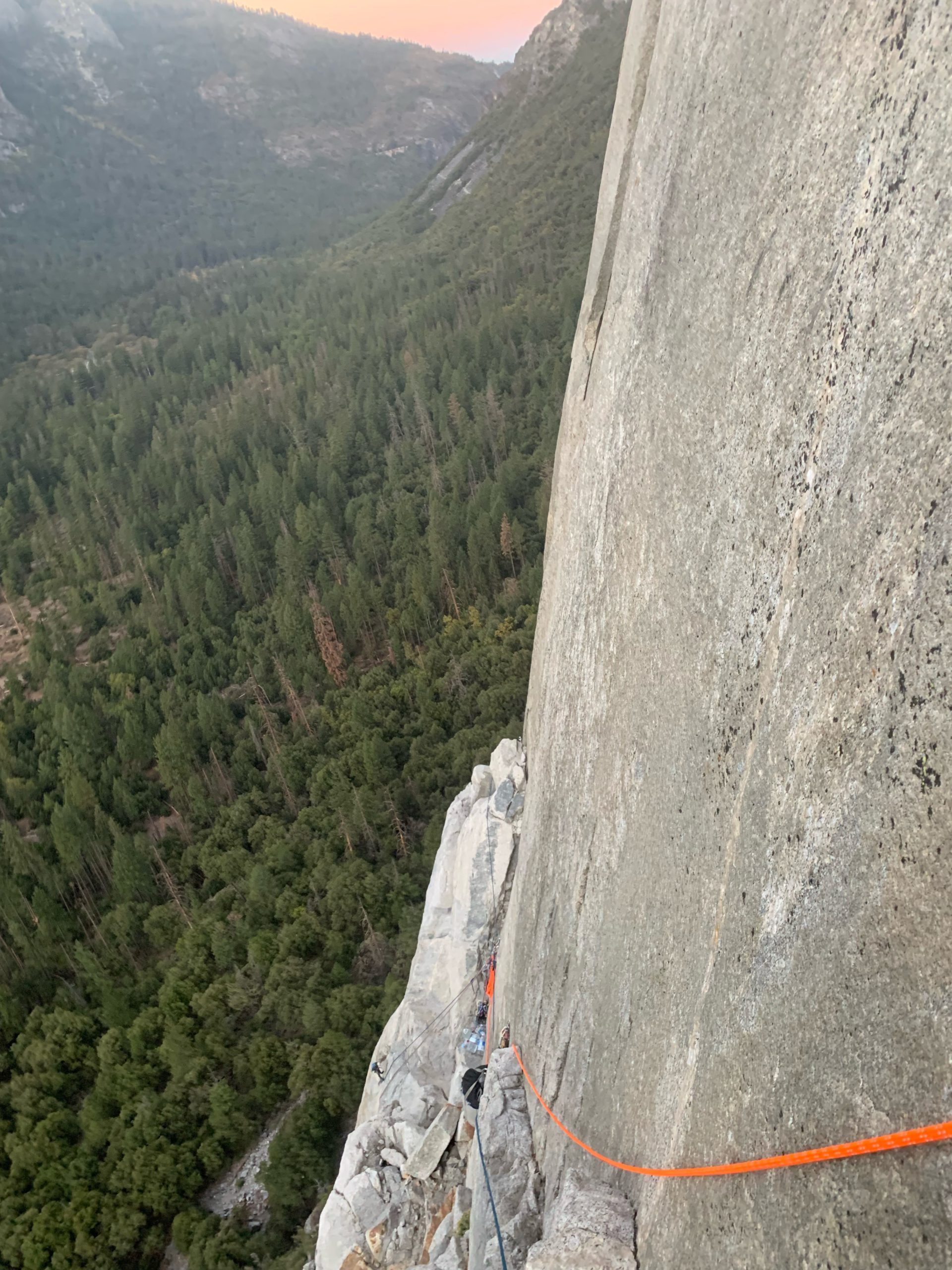
The romp up Sickle was a blast, and I was psyched to see no parties ahead of us. I pulled the final few crack moves to exit the Sickle, clipped the pendulum bolt, and swung over to the anchor below, my first block complete. Hunter jugged off of me and swung over to join me. I untied and pull my rope through while he geared up for the next block.
Hunter crushed the route finding through Dolt Hole and into the Stovelegs and soon it was time for me to start jugging. I soon reached the pendulum into the Stovelegs and set up for my first every lower out. The previous night’s lessons paid off, and I lowered over to the Stovelegs, marveling at the perfect splitter crack stretching above me. Hunter continued to make smooth progress up the widening crack, and I finally caught Hunter on top of Dolt Tower. We had been on the move for about 4.5 hours. Dolt Tower is generally considered about a quarter of the way for NIAD, and is the last super easy place to rap with a single 70m rope. We chatted briefly and were both on the same page; things were going smoothly, the weather was great, and we were psyched to commit to going to the top.

The full scope of the day now before us, we grabbed a quick snack and then Hunter set off to take us to El Cap Tower. Hunter may have placed a few more pieces than Brad Gobright, but he crushed the final section of his block and brought us safely to El Cap Tower and the base of the infamous Texas Flake.
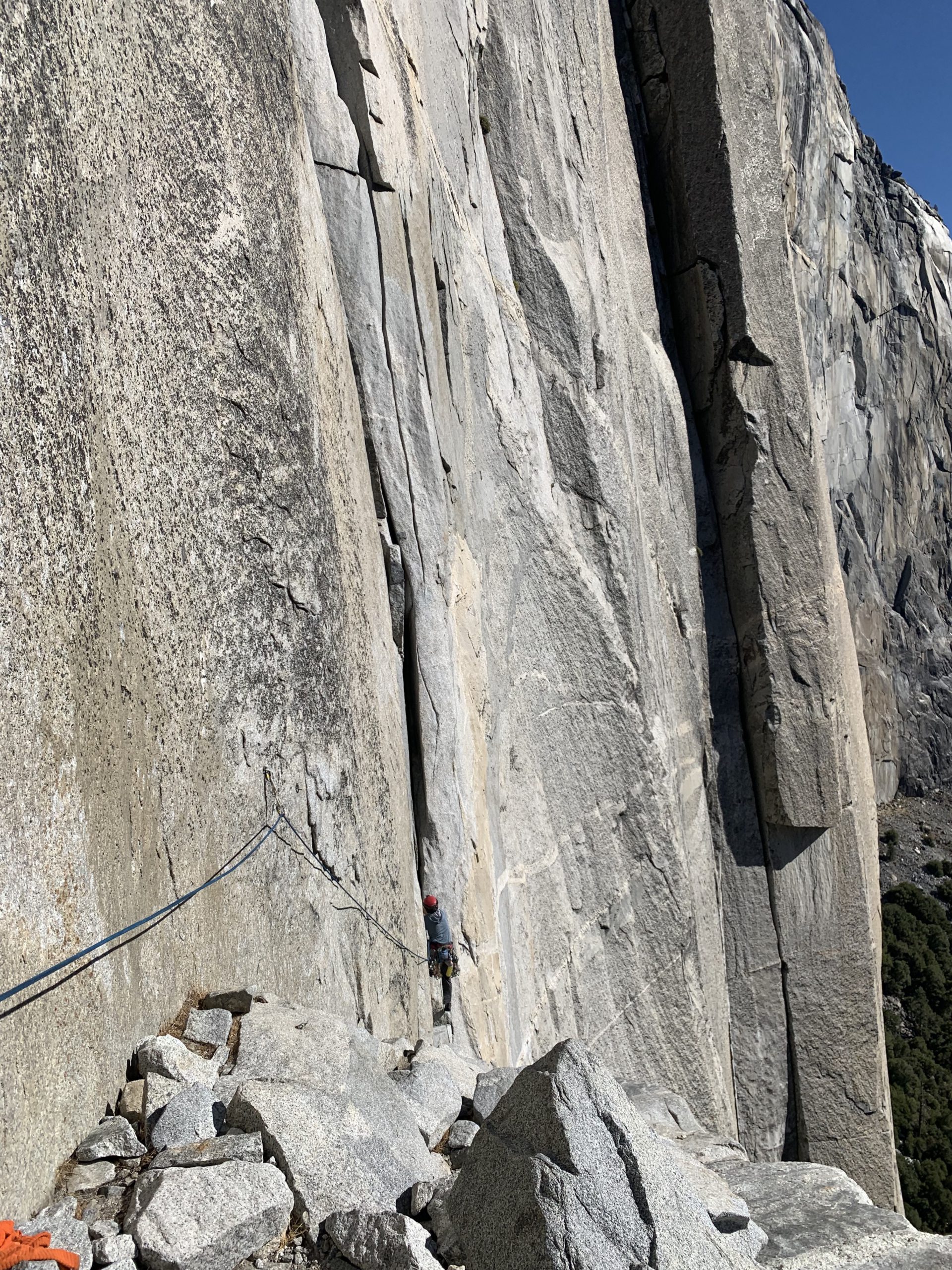
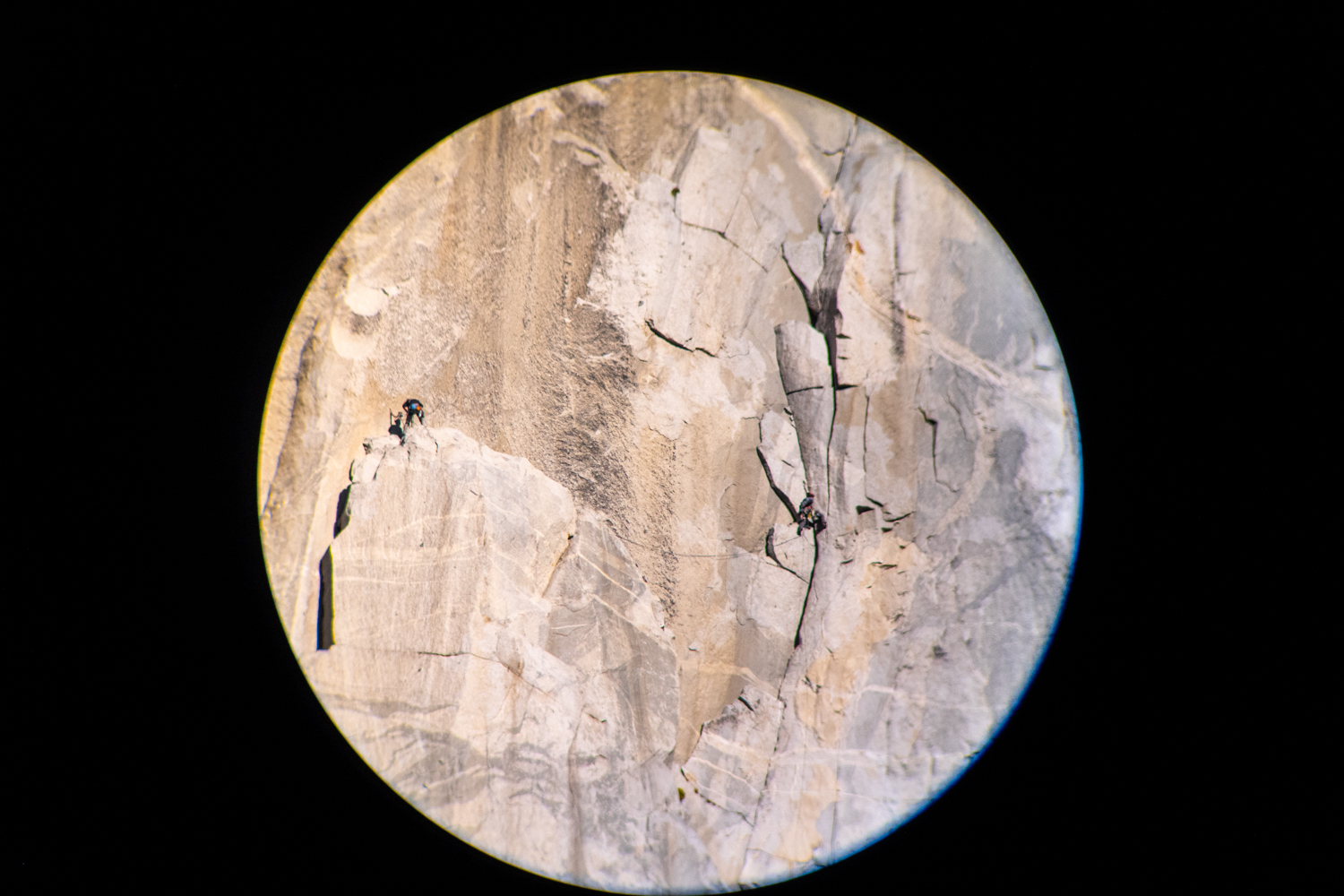
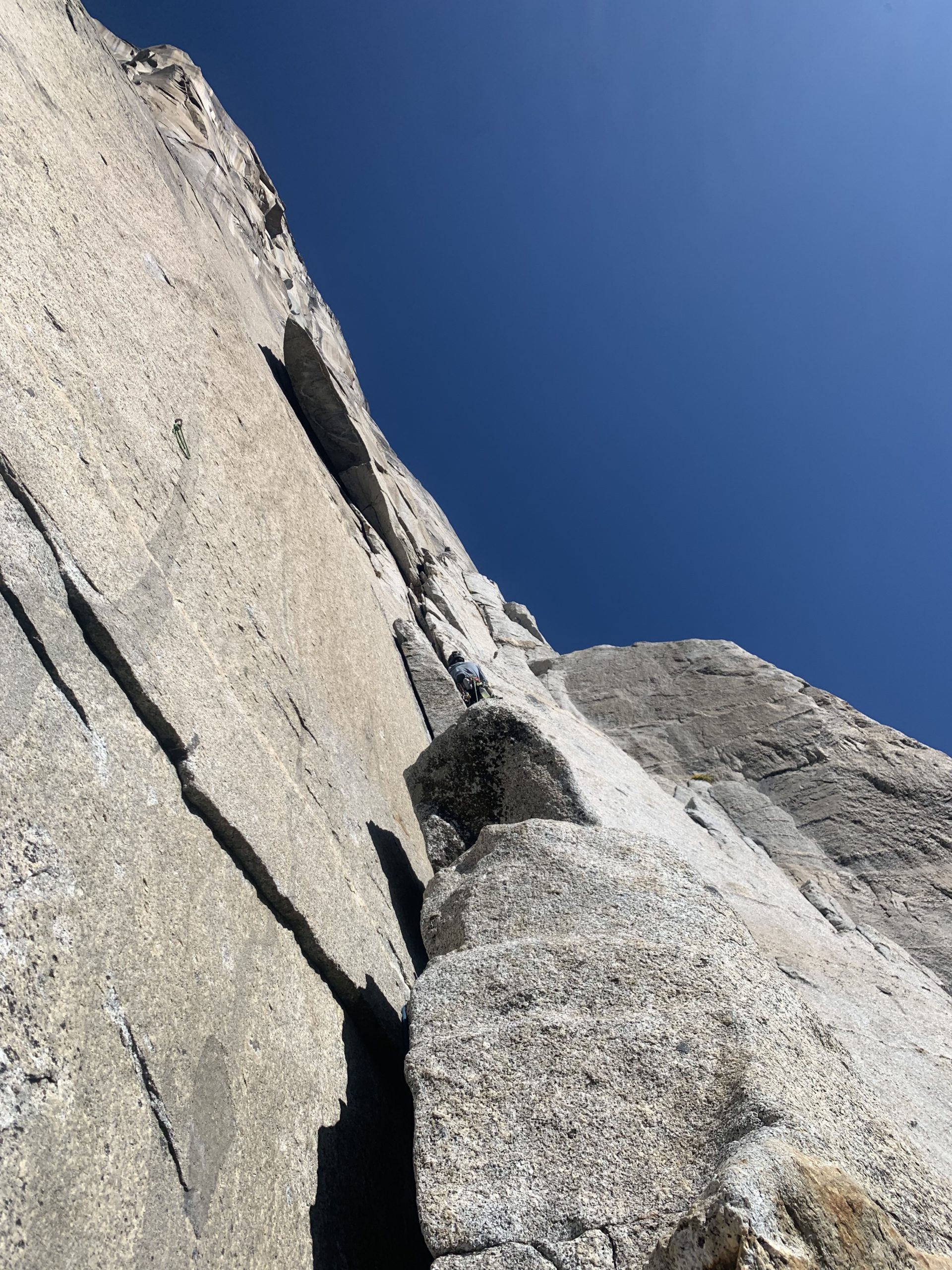
Loaded up with gear, I took over the lead. The chockstones that guard the entrance to the flake were awkward to navigate with a full harness, but after a bit of wriggling I squeezed through and eyed up the chimney above me. The walls were surprisingly narrow at floor level but seemed to open up higher up. I opted to skip the lone bolt so I could later flick the rope outside the flake. This freed me up to walk further behind the flake towards the edge to where I had heard the chimney was easiest. The first ten feet or so was secure tight chimneying with my knees and hands on one wall and my feet and elbows on the other. The chimney soon opened up too much for this to be feasible and I worked through a couple feet of uncomfortably tight, knees-near-my-shoulders chimneying before things widened enough for perfect-width, super secure, traditional chimneying. Eventually I was able to grab the edge of the flake and made the last couple of moves and mantled onto the top of the flake. Breathing a sigh of relief, I flicked the rope to the outside of the flake and fixed it to the anchor so Hunter could start jugging.
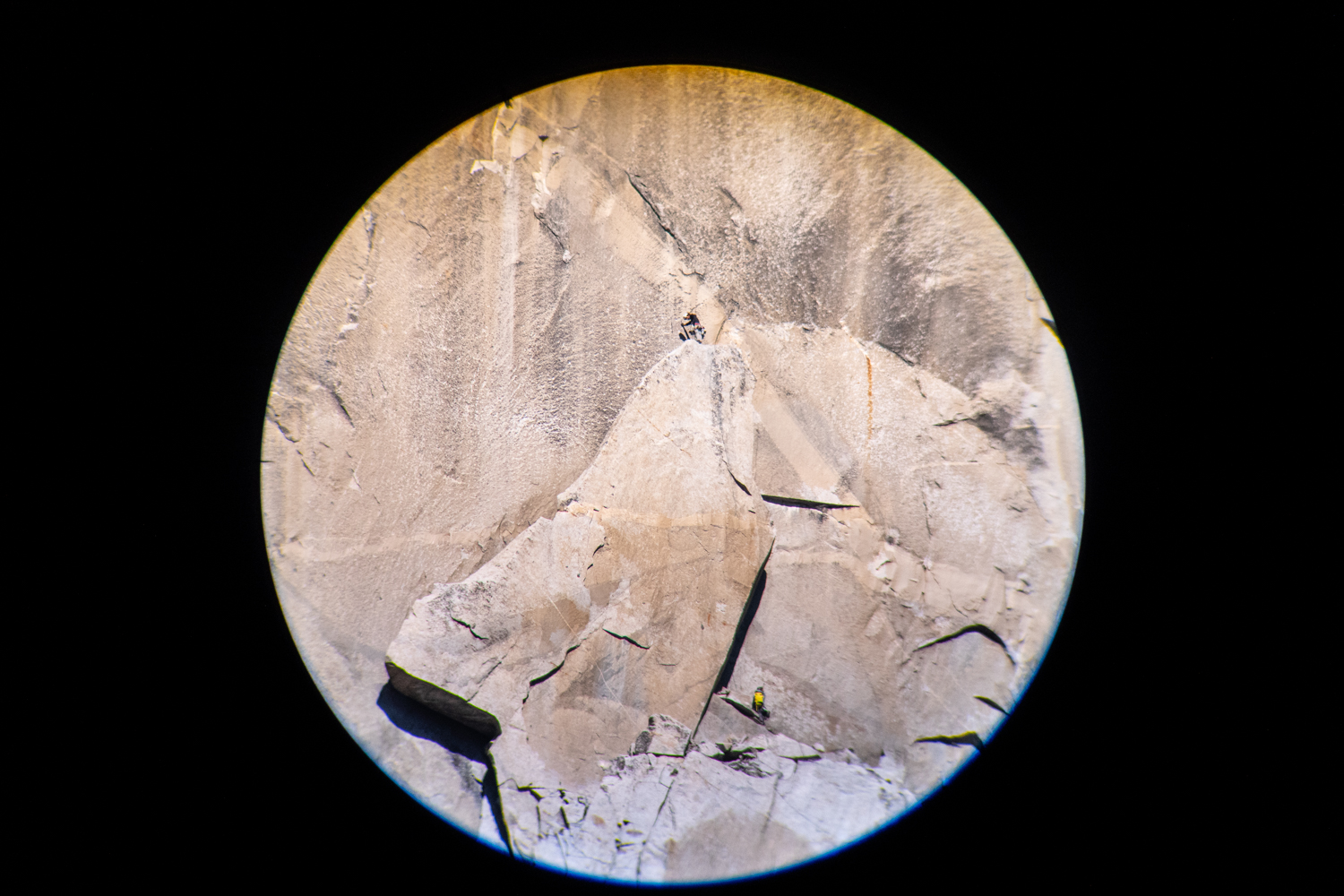
From there I set up the bolt ladder towards the Boot Flake. The cam hook move off the bolts went smoothly, and then I was into the splitter crack to the top of the Boot.
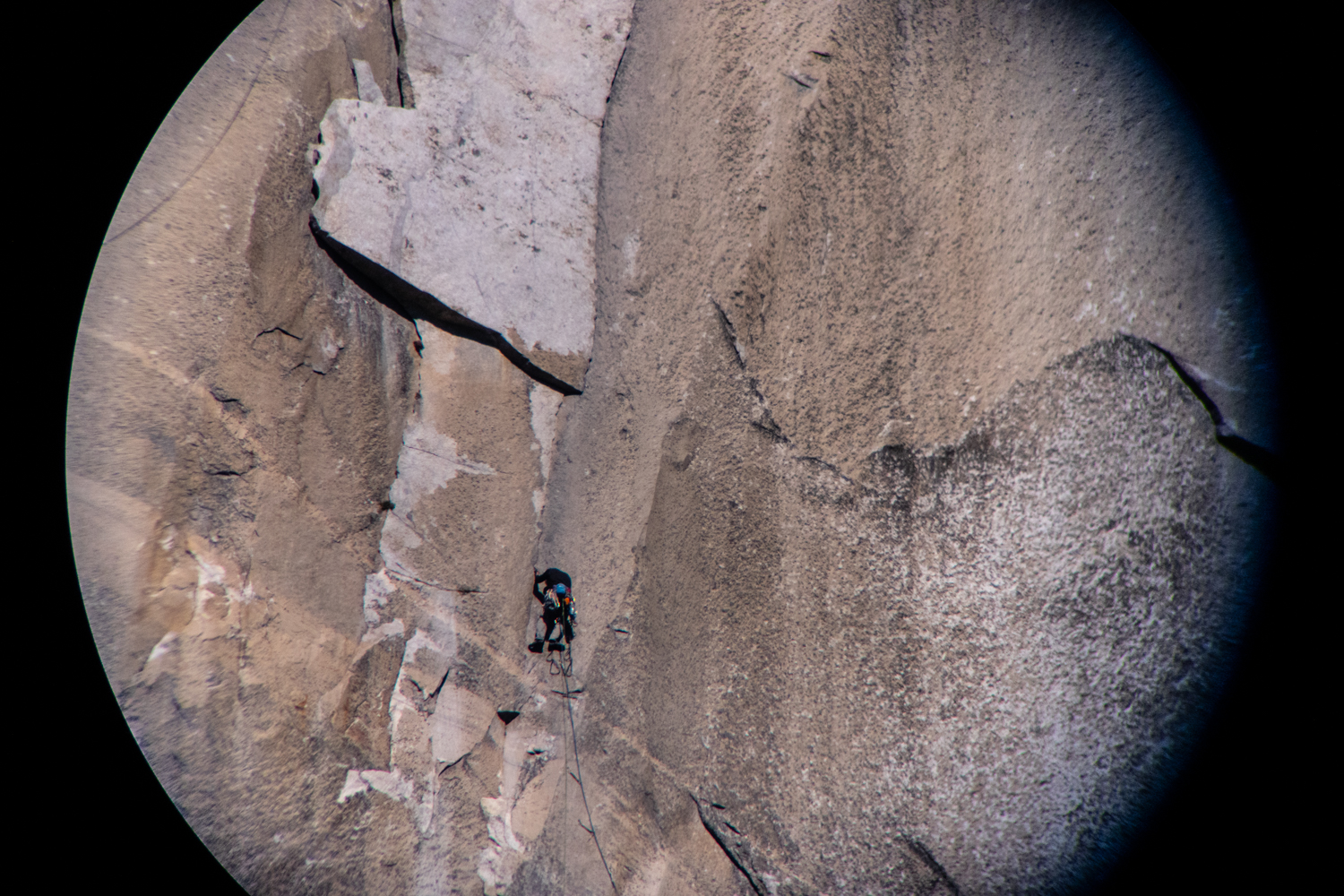
Atop the Boot I ran into our first party of the day. We chatted while I untied and threaded my rope through the anchors. Hunter lowered me and I gave a test swing. Unfortunately, the group above yelled down that my rope was rubbing across their gear and asked me to wait while they finished lowering out the bags.
Hunter and I hung and chilled for five minutes before growing impatient. The problem is that NIAD parties operate on entirely different time scales than wall climbers doing it over a couple of days. Spending 30 minutes navigating a complicated bag lower-out may seem like nothing for a group doing the wall in three days. But for Hunter and I, sitting in our harnesses, sipping our dwindling water supply, 30 minutes feels like an eternity after a morning of constant upwards progress. After another five minutes of waiting, I yelled back up to see if they minded me giving the swing another go. They did, but kindly proposed that they could lower a loop in their haul line so I could statically pull myself across to Eagle Ledge. While I was bummed not to get to experience the full King Swing, it definitely beat waiting for them to finish their gear shenanigans so I took them up on their offer.
Knowing I could get across statically, I decided to test an idea I had to help make it easier for groups to do the double swing (the name given to the strategy where the follower also does the King Swing rather than jugging up the Boot and lowering out). I took the other end of my tag line and fixed it to the last bolt and then pulled myself across to Eagle Ledge.
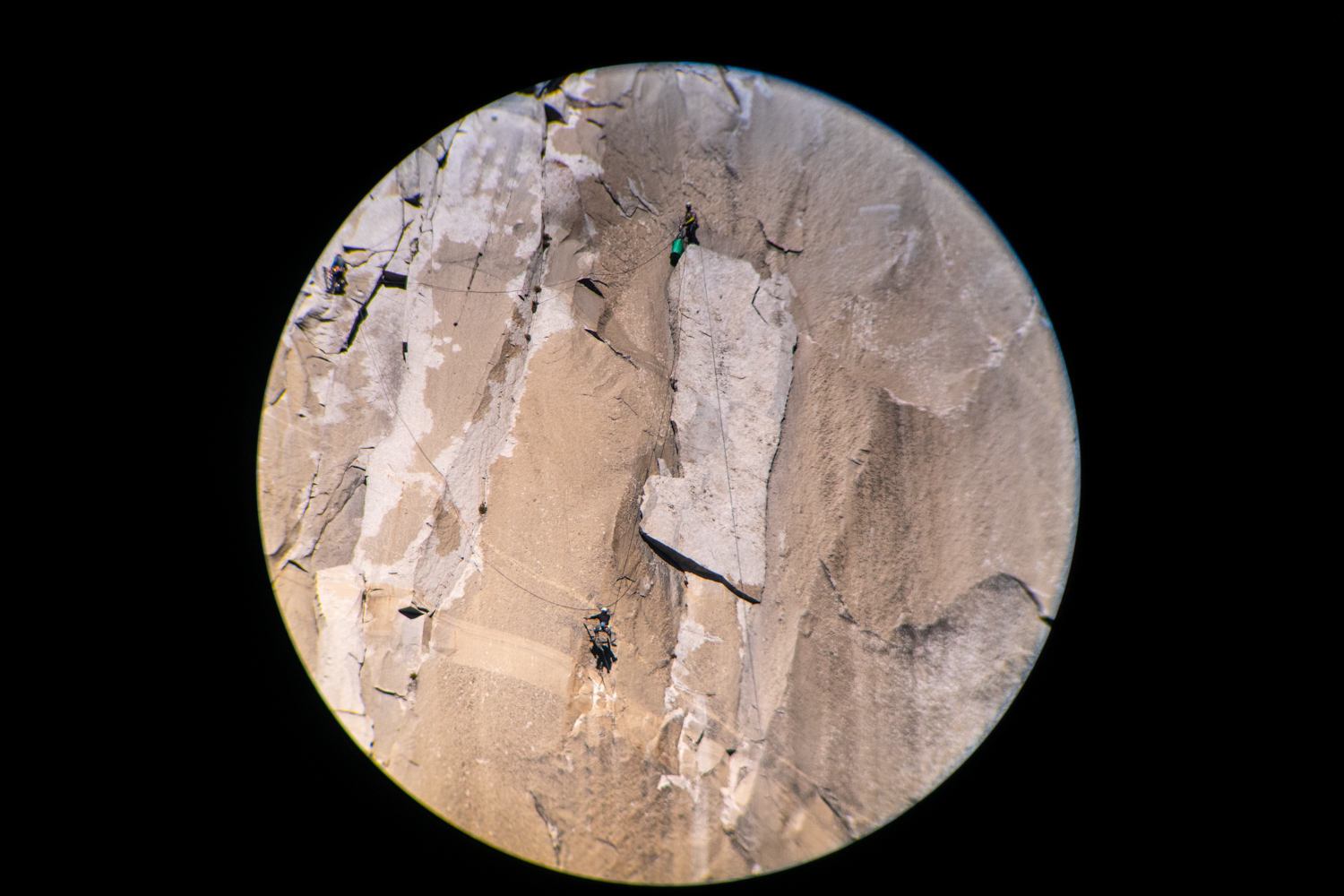
Luckily the tag line was just long enough, and I clipped into the Eagle Ledge anchors with no issues. From there Hunter jugged up to the pendulum point and then used our tag line to pull himself across.
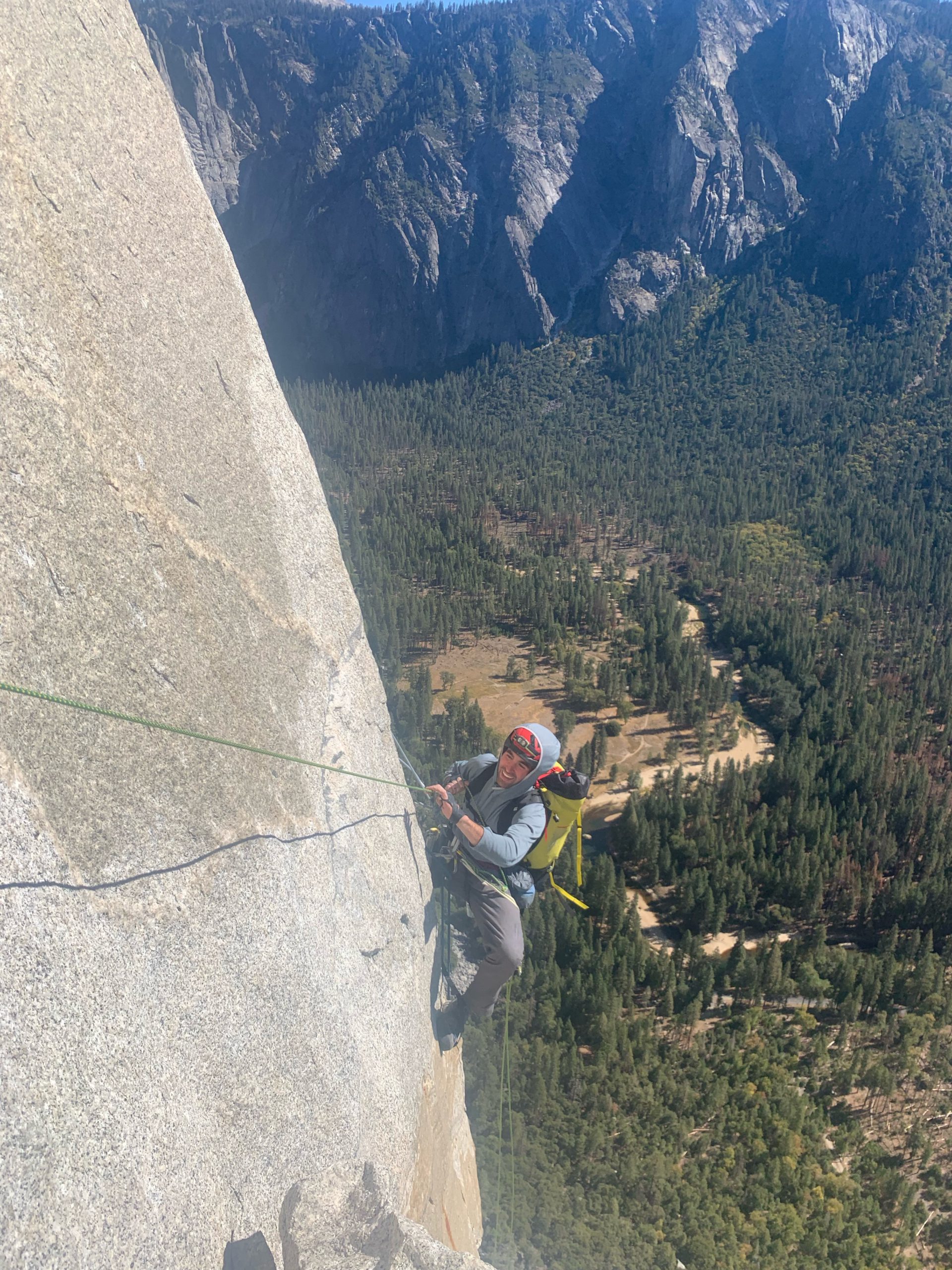
This little trick definitely wouldn’t be necessary for fast NIAD parties, but is a nice way to guarantee the follower can get across first go, even if carrying a heavy pack.

Hunter united and pulled the rope through and then I started up towards Camp IV. There was a bit more rope shenanigans clearing ourselves completely of the traversing group, but I arrived shortly after at the Lynn Hill Traverse. The face climbing on this traverse offered a nice change of pace from all the crack climbing we had been doing and I was halfway through the traverse before Hunter caught me and put me on belay.
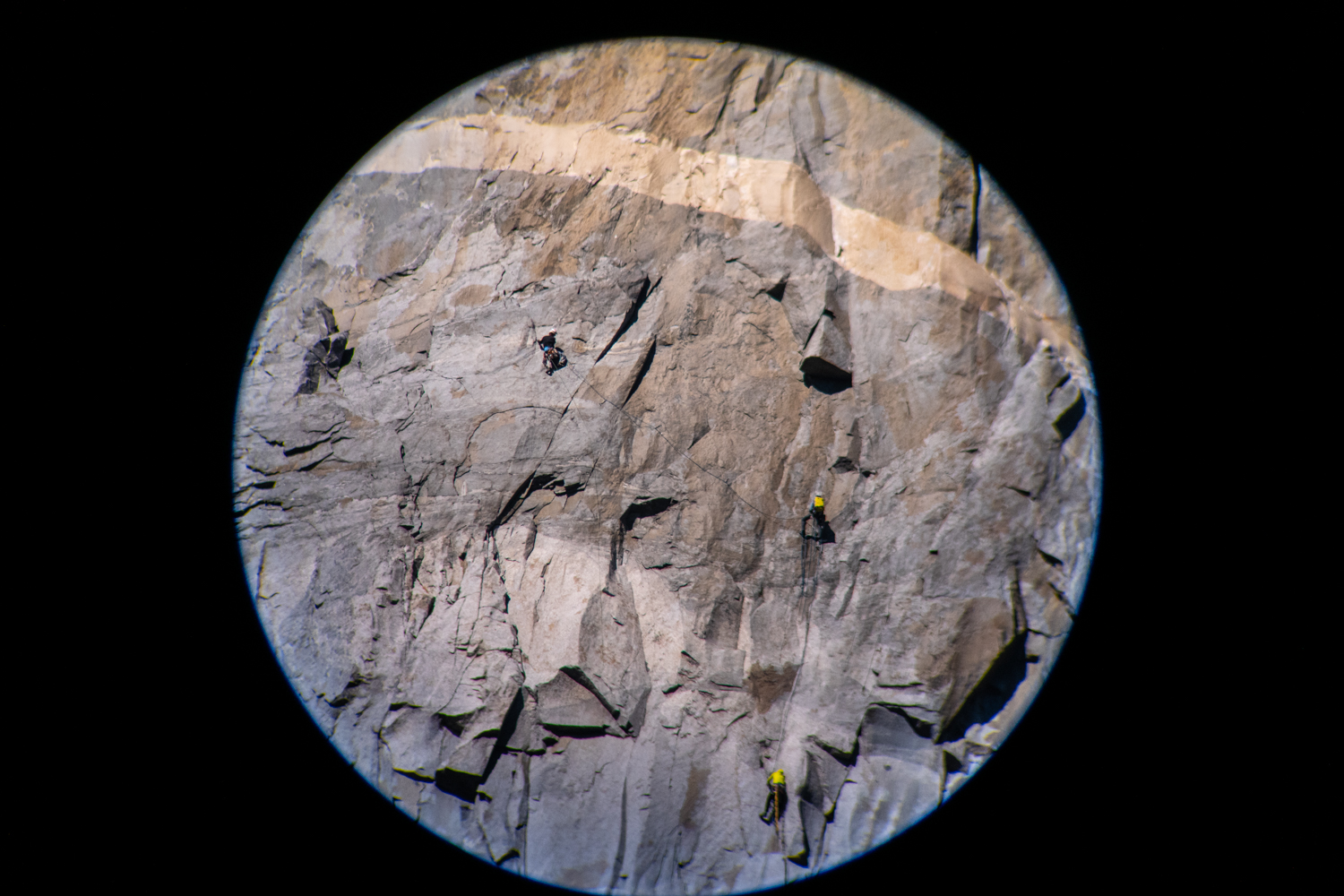
The remainder of the climbing through Camp IV to the base of the Great Roof was relatively straight forward. There were a couple sections of surprisingly poor rock, but otherwise the climbing was fairly simple. Following, on the other hand, was anything but. The traversing nature of this section meant repeated lower-outs for Hunter and I could tell he was ready to switch roles and not have to worry about rope management when he joined me at the anchors below the Great Roof.
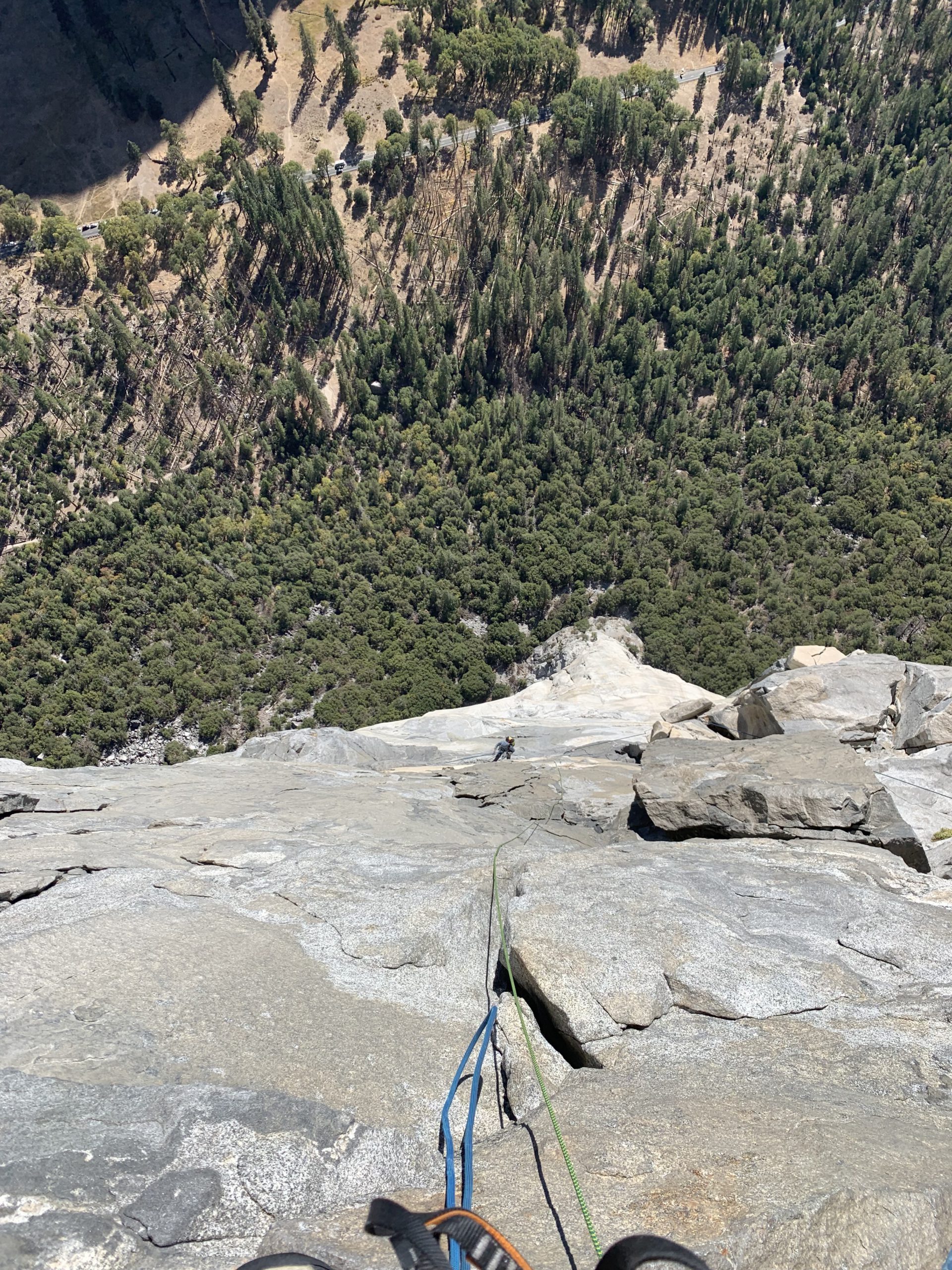
The base of the Great Roof is generally considered halfway time-wise for NIAD despite being considerably more than halfway up the wall. This is largely due to an increase in the amount of mandatory aid in the second half. We were still around 18 hour pace, and with the top starting to appear closer, we knew it was a matter of just continuing to try to make smooth, consistent upwards progress.
Hunter launched up the corner leading into the Great Roof while I sat on the little ledge, enjoying one of my first moments of non-movement of the day and savoring (at least of the time being) the slower pace of aid climbing.
All day we had been remarking on the surprising absence of fixed gear on the route, and the Great Roof was no different. Apart from two equalized nuts at the start of the roof, the roof itself was entirely devoid of any fixed pieces. I held my breath as Hunter worked out the roof, watching as he back cleaned his gear as he went so I would be free to lower out off the fixed nuts. Reaching the end of roof, Hunter tiptoed across to the anchors and fixed the line. Hunter later informed me that he had done most of the roof with cam hooks. The idea of a single cam hook being the only thing between him and a massive swinging fall seems horrifying, but Hunter claims it felt “very chill”. Psycho.
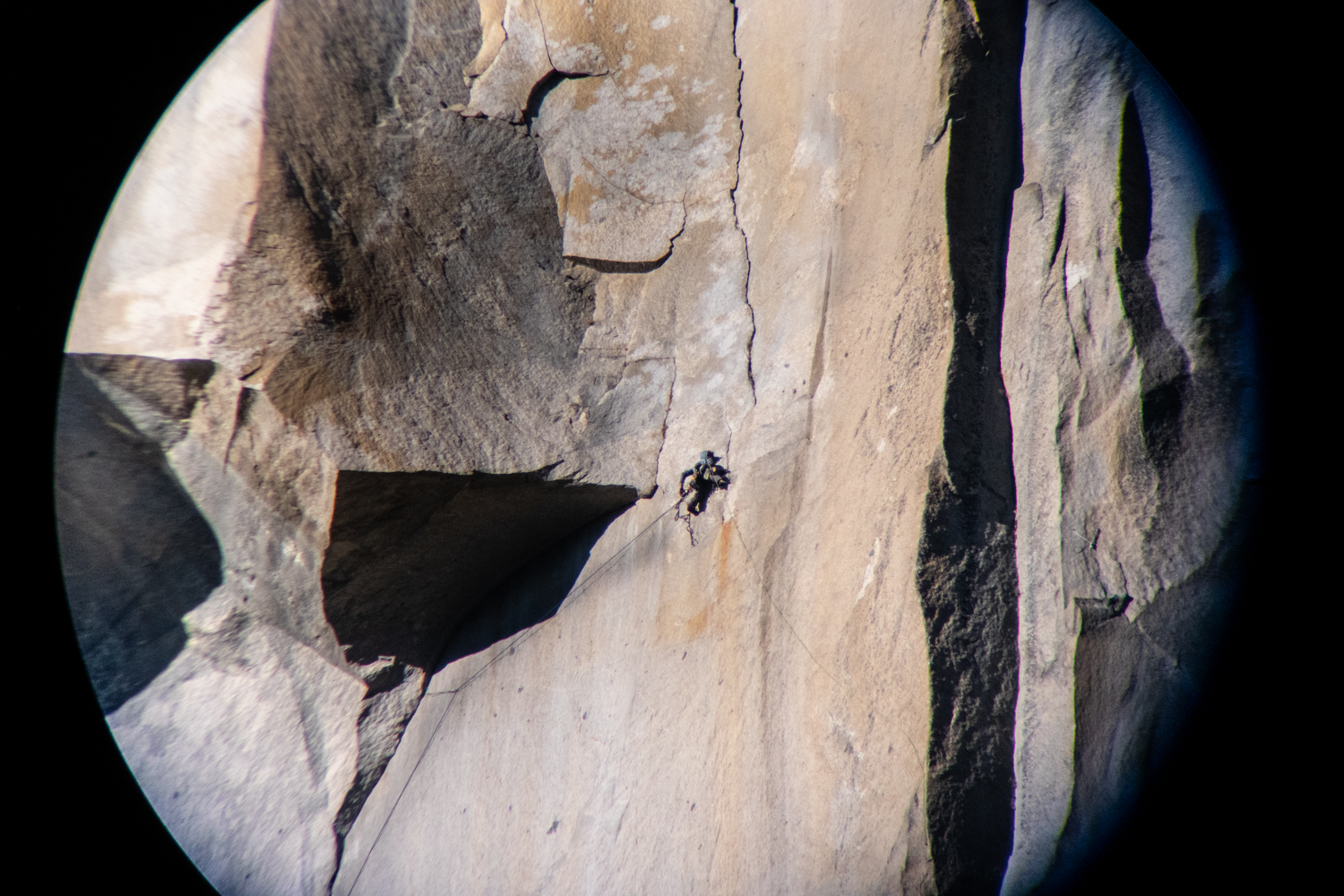
Hunter continued up the Pancake Flake as I jugged the Great Roof, tenderly lowering myself off the fixed nuts and over to the belay.
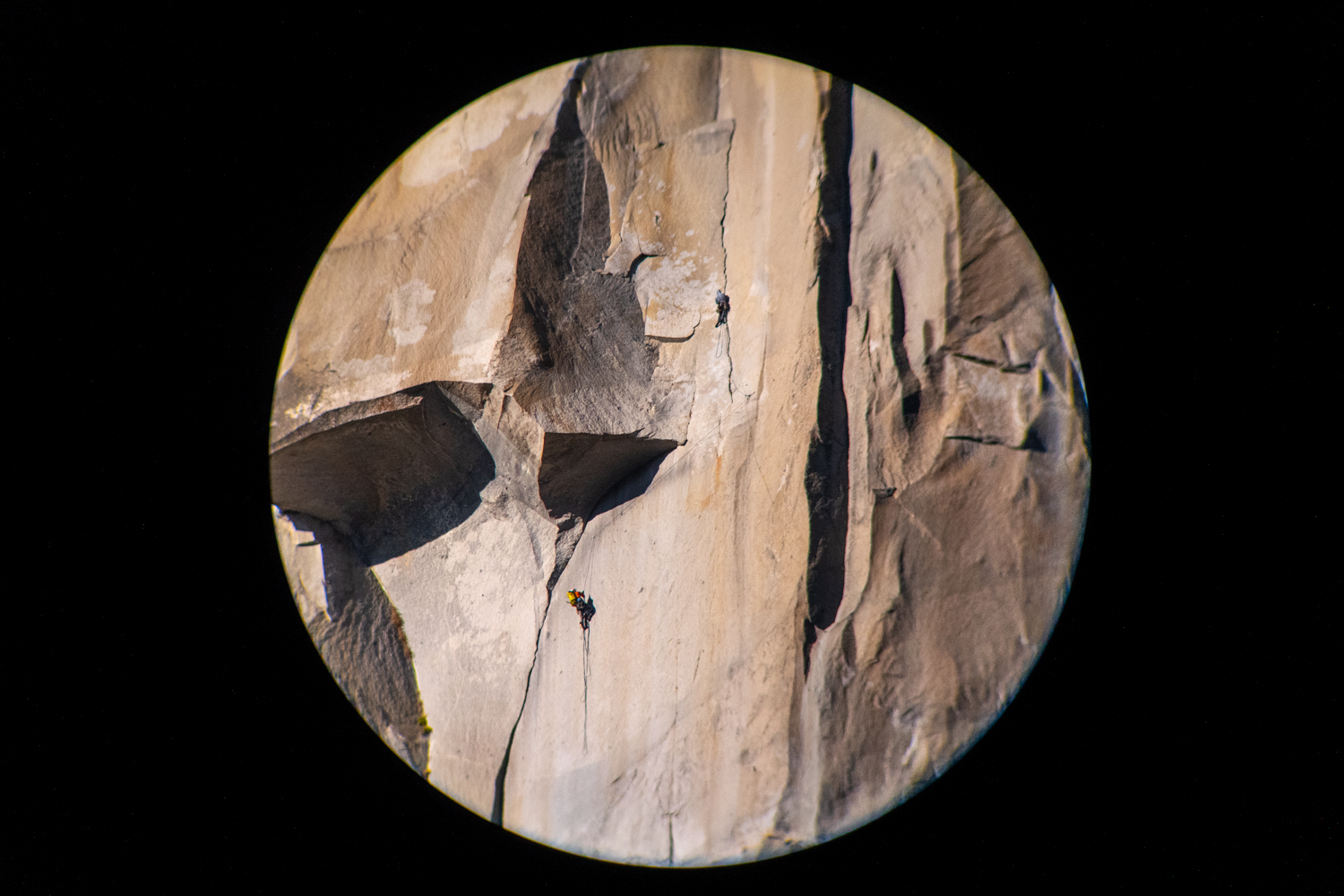
Hunter’s block continued through the Glowering Spot, and I caught him before he set off up the thin crack at the start of the pitch. Despite having been on the go for over 12 hours at this point, we were still solidly in the type I fun category. Only seven pitches away, the top now no longer looked comically far away, and we savored the last rays of sunlight, the walls awash in a perfect alpine glow.
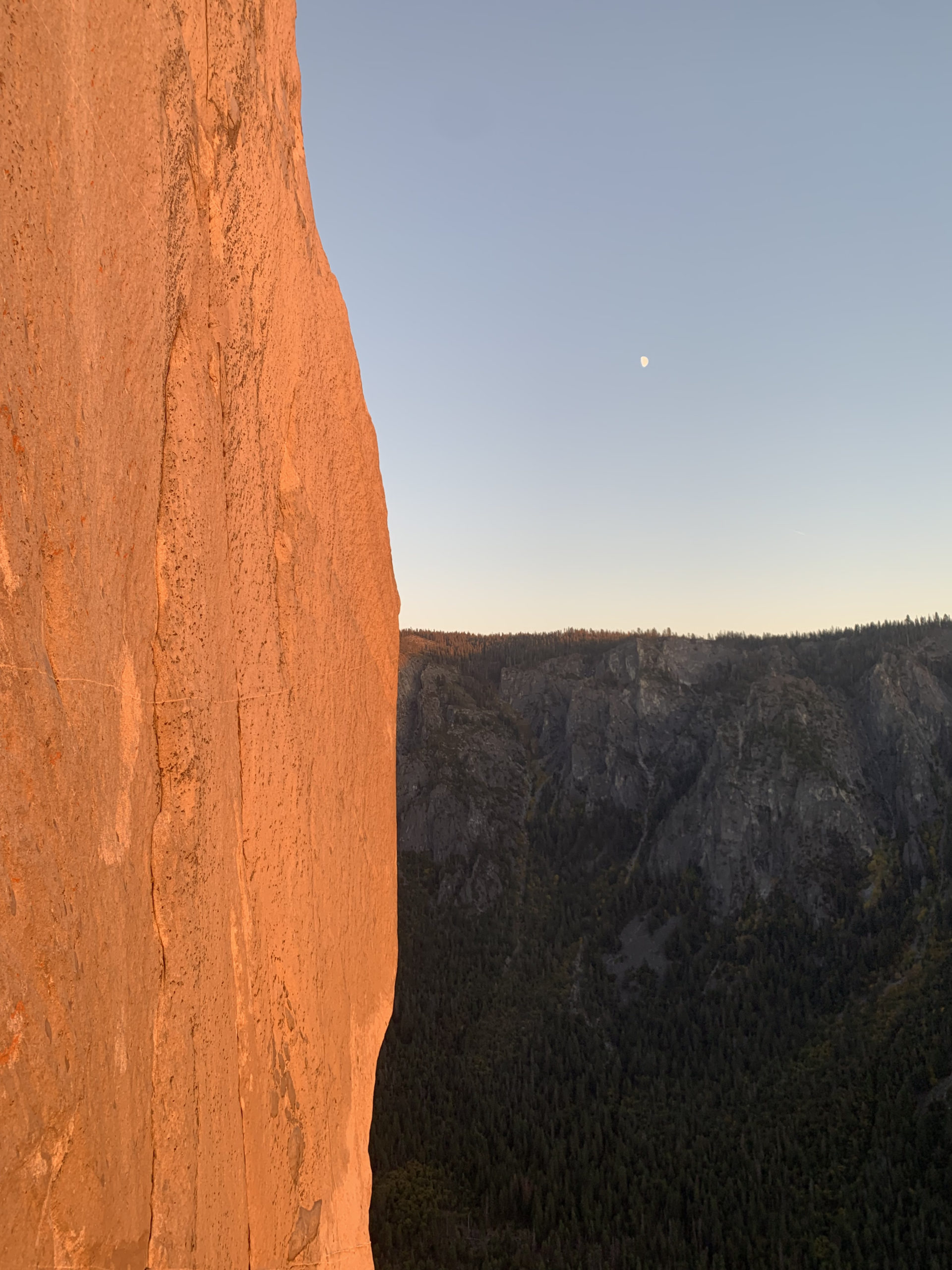
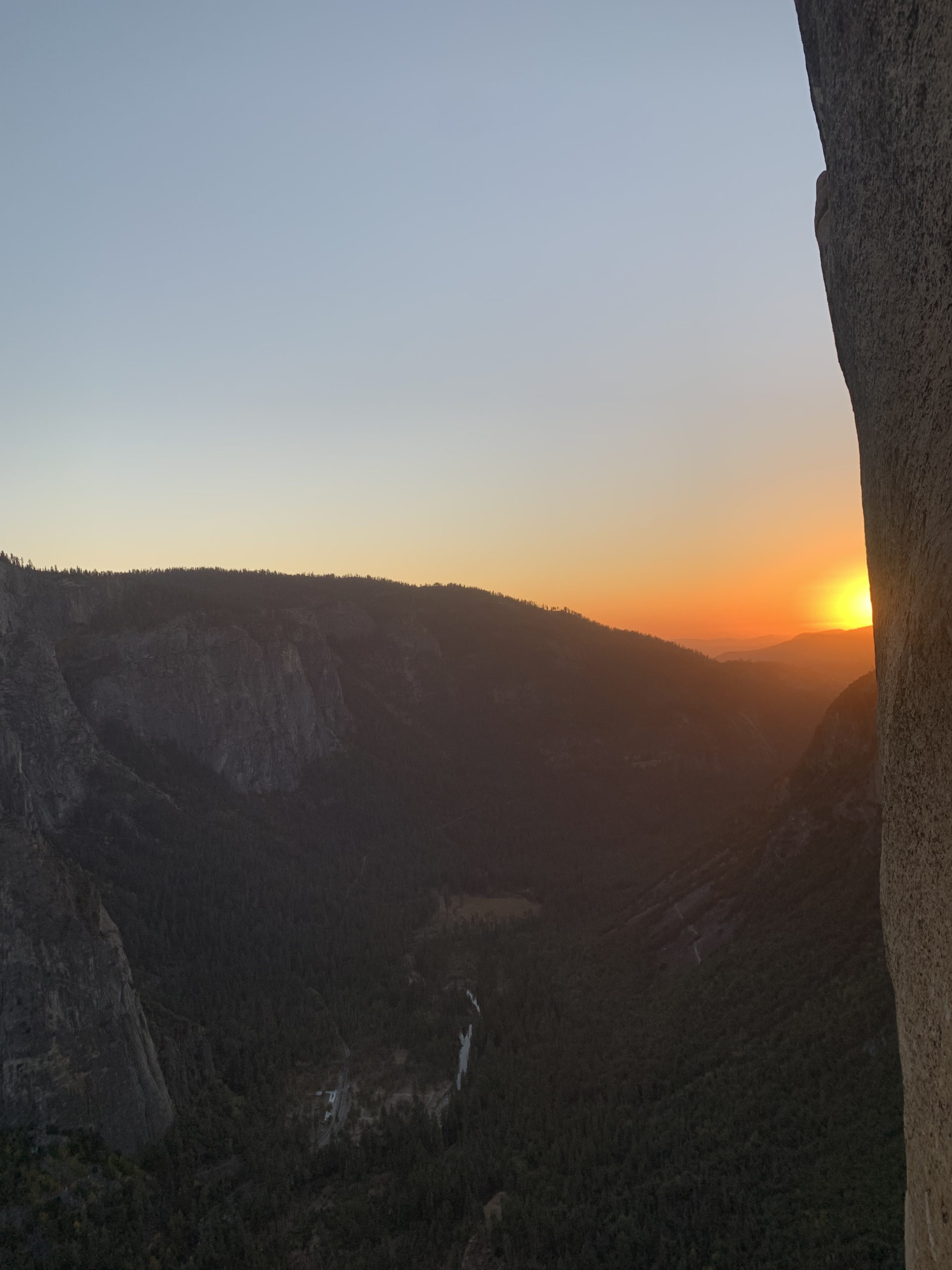
I took over for the final block at Camp VI. Starting up the initial 5.8 section of the Changing Corners pitch I could not believe how tired my arms were. 2500 feet of climbing and jugging had finally caught up to me, and I struggled to hang on on even the largest jugs. The free and french-free climbing I had been enjoying in my previous lead blocks had come to an end and I knew it was going to be pretty much entirely aid climbing to the top. With that realization, I settled into my groove, and started the slow, rhythmic march upwards.
Figuring out where to “change corners” proved to be a bit tricky in the dark, but with a bit of uncertainty I swung over and worked my way up the thin seam. The corner prevented otherwise solid looking cam hook placements and this section proved to be my most difficult section of aid climbing for the day, with several nuts I placed falling out after I pulled past them. Luckily I made it to the anchors will no falls, and with only four pitches left (and no more tricky aid) I knew we had it in the bag.
The link cam proved shockingly useful over the next two pitches as a good 90% of the climbing was in the 0.75-2 range. The perfect splitter cracks called out to me, but my arms were too toast to engage, and I ignored their taunts as I bumped my cams over and over, defiantly hanging in my harness with every move.
A wave of fatigue hit me as I pulled onto the Wild Stance and prepared for the final section of climbing before the bolt ladders. We had long ago run out of water (save a couple celebratory sips saved for the summit) and the lack of sleep the prior night had finally caught up to me. I reminded myself that I was almost there and tried to relax into the dream-like state of movement that always seems to eventually hit on long days out. Hunter got up to the stance as I was approaching the start of the bolt ladder and yelled up that he was feeling the same way.
The spacing on the bolt ladder was trickier than I expected and despite my best efforts to enjoy the victory lap I was just so, so ready to be on flat ground and out off my harness. I did have enough spare energy to muster a shudder as I thought about Brad Gobright mono-ing the bolts with no gear between him and the bottom of El Cap.
I worked my way out the final bolt traverse and then it was just a mellow scramble between me and the famous summit tree. I crawled my way towards the tree, cursing at the rope drag I had given myself. I leaned towards the tree to touch it and, with my fingers inches away, felt the rope go tight. Leaning against the rope, I tried again and once again came up short. I realized that in my hurry I had failed to pull up enough rope before fixing it to the final anchor for Hunter to jug off of. Resigned, I sat down behind a small manzanita bush and waited for Hunter to get to the anchor.
My poor planning did have a silver-lining though. As Hunter unfixed the rope from the final anchor and began to work up the slabs towards me I realized there was in fact no gear between us. A perfect opportunity for a “No gear, no falls” yell! We were true speed climbers now.
With some slack now in the system I moved up and tagged the tree. As Hunter got close to the tree, a loop of trailing rope snagged somewhere and he too came up short. I couldn’t help but laugh as he was forced to stop and untie before he could tap the tree. These last few feet weren’t coming as easily as I expected!
In the end we topped at in just over 18 hours. At this point we were just happy to be on solid ground. We each took our victory sip of water and then started on down towards the East Ledges descent.

The East Ledges descent ended up being simpler to onsight than I had expected, but we felt every 3,000 feet we had just ascended. Adam was an absolute saint and came and scooped us from the trailhead at 3am. We collapsed in the tents as soon as we got back to camp and I fell instantly asleep.
Below is the locations of the various photos shown above.

Climbing NIAD was definitely a highlight of my climbing career. While I am certain I can go faster than 18 hours in a future attempt, I am incredibly proud of the effort we put in. To just get up the Nose in under 24 hours is certainty an achievement, and doing it first try on my first trip to the valley is definitely rewarding. In the end it ended up being a much less miserable and scary experience than I expected. Other than some serious thirst on the last few pitches, we experienced very little discomfort. Both Hunter and I agreed it was less suffering than running an ultra. Even better, I felt like we took almost no extra risk to climb it in a day compared to climbing it over several. The self-belaying with a gri-gri worked well enough to avoid using the PDL (Pakistani Death Loop), and with the ability to french-free, I felt like I was running it out above gear less than I normally do trad climbing. I’m sure to go very fast you need to cut some serious corners, but I definitely came away feeling like NIAD is a reasonable goal for anyone who can climb 5.11 trad and enjoys efficient transitions and rope work.
In terms of gear, I felt we were just about perfect. I was skeptical of the link cam at the beginning, but it proved to be a huge time saver above the Great Roof where much of the climbing is on thin hand cracks. The thin tag line worked out great and I will definitely keep the tag-assisted double swing in mind for next time. More water would have been nice, but I don’t know if my biceps could have handled jugging with a heavier pack. All in all, the logistics came together pretty perfectly for a first time up El Cap.
Hunter and I woke up earlier than expected the next morning due to throbbing hands. I could barely get my shoes on to get out of the tent. It turns out that dragging your knuckles against 3000 feet of granite is enough to make them pretty sore. Who would have guessed?
We decided to head to El Cap Meadow for the day to soak up the beautiful weather and enjoy a very earned rest day. For the first time all trip, I felt truly at peace just relaxing in the Valley. The weather was blissfully warm, and gazing up at El Cap took on whole new meaning now that I had been to the top of it.
The prior day’s effor must have left me looking haggard, however, because I had not one, but two different strangers come and gift me food. The first time, Hunter and I were sitting on our crash pad, looking at the wall when an older lady came and offered us a pack of cupcakes. Later in the day, while Hunter was belaying Adam on the first pitch of the Nose, I got chatting with a friendly tourist about climbing. He disappeared for a bit and came back with a humus and cheese sandwich, saying he had made an extra while making lunch at his car.
I’m not sure what vibes I was giving off, but I need to figure out how to reproduce them. I was probably averaging 500 calories/hour of free food that afternoon, a personal best for sure, and certainty more than enough to live in the Meadow indefinitely if I could make it sustainable.

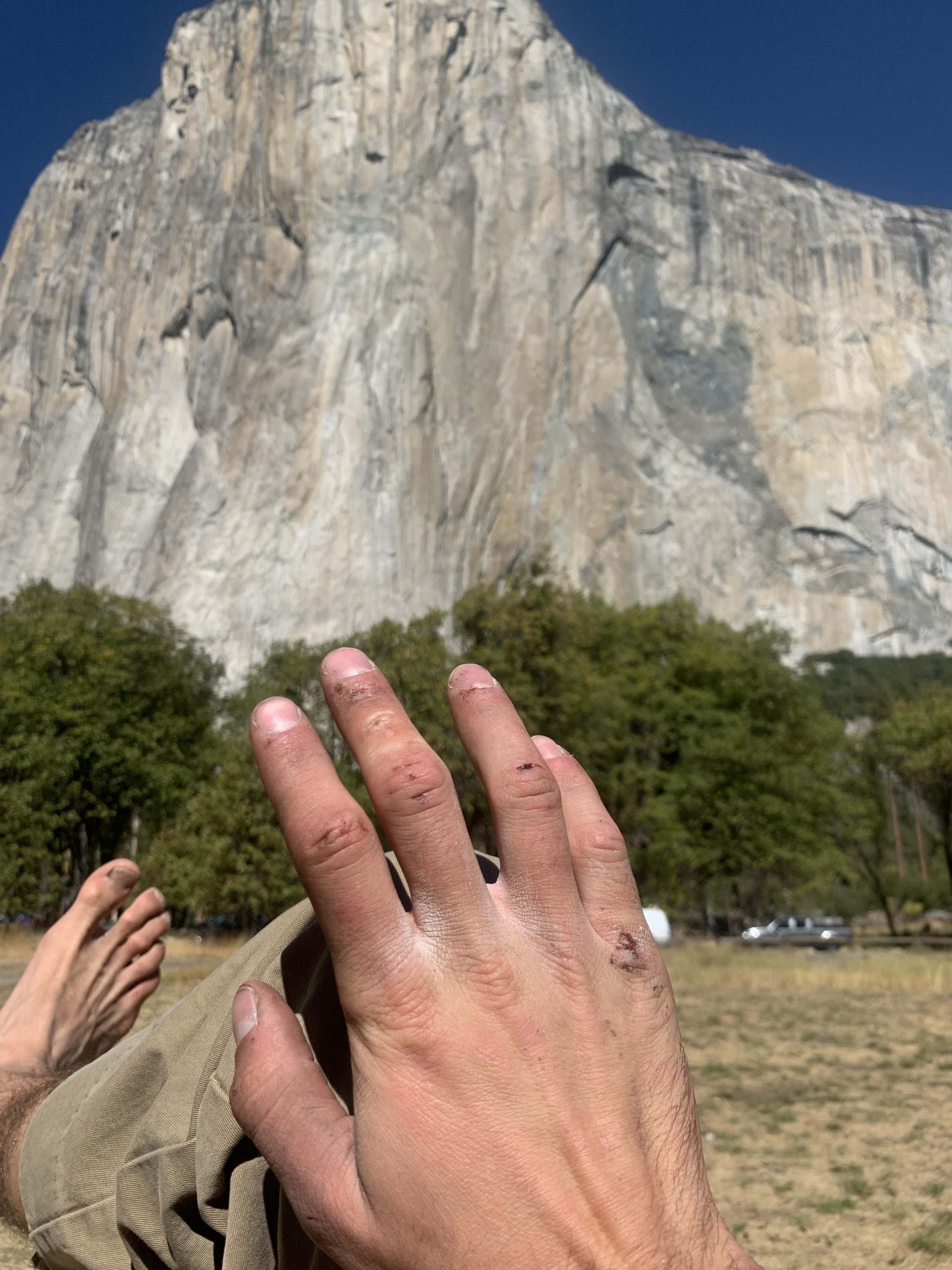
The next day was our final day in the Valley. Adam had been an incredibly good sport about watching his two friends tick off one of his lifetime goal right in front of him, so we did our best to brainstorm something that would give him at least a little more time on rock. We settled on a party climb up Royal Arches with Adam leading while Hunter and I simul-climbed behind. It was a blast to turn my brain off and chat with Hunter as we rambled up the climb, following Adam through the wandering terrain. Slightly less enjoyable was navigating the hanging anchors down the seemingly endless rappel line as a party of three. But luckily the rappels went smoothly, and we arrived at the base a bit over 4 hours after departing.
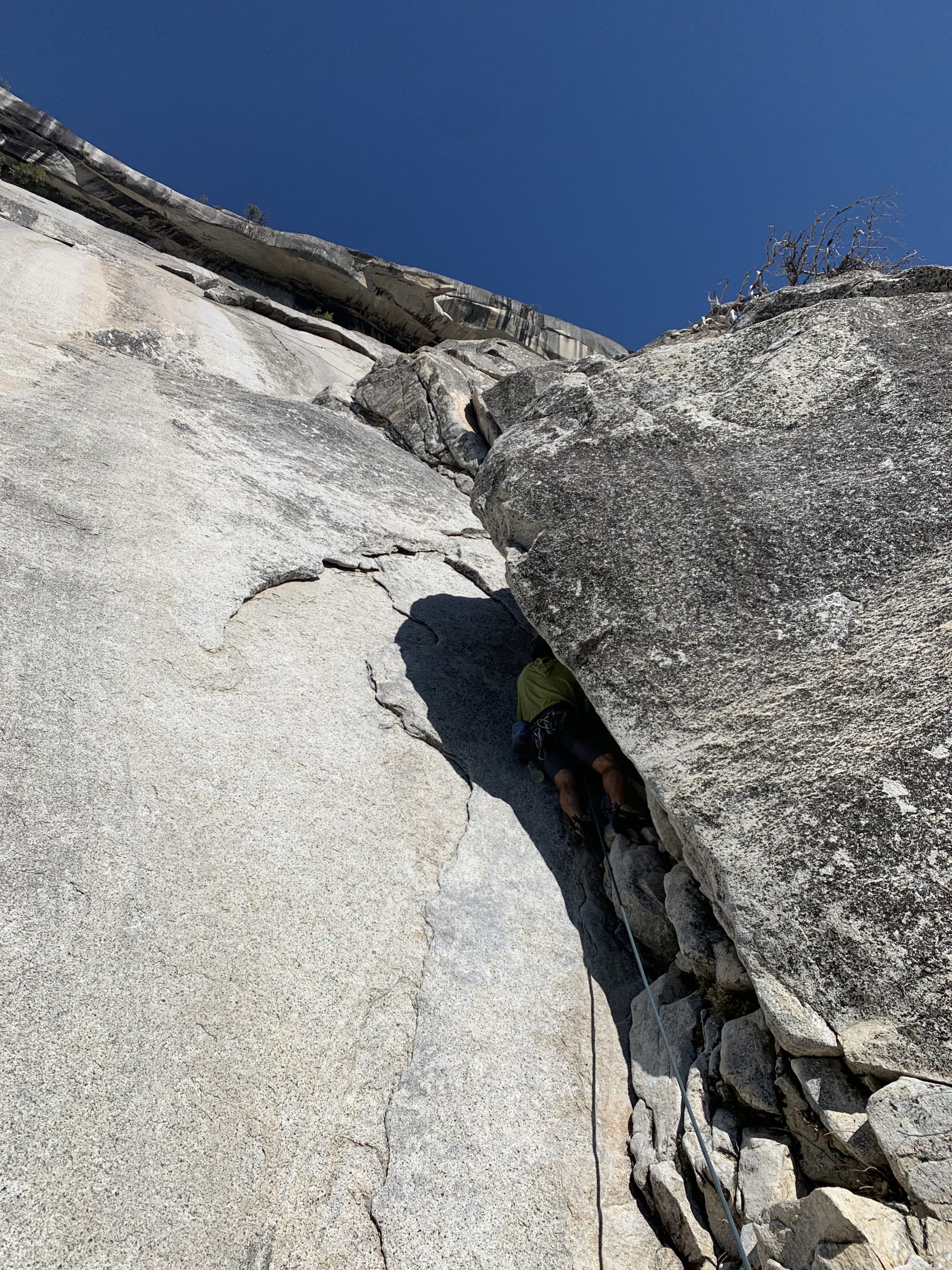
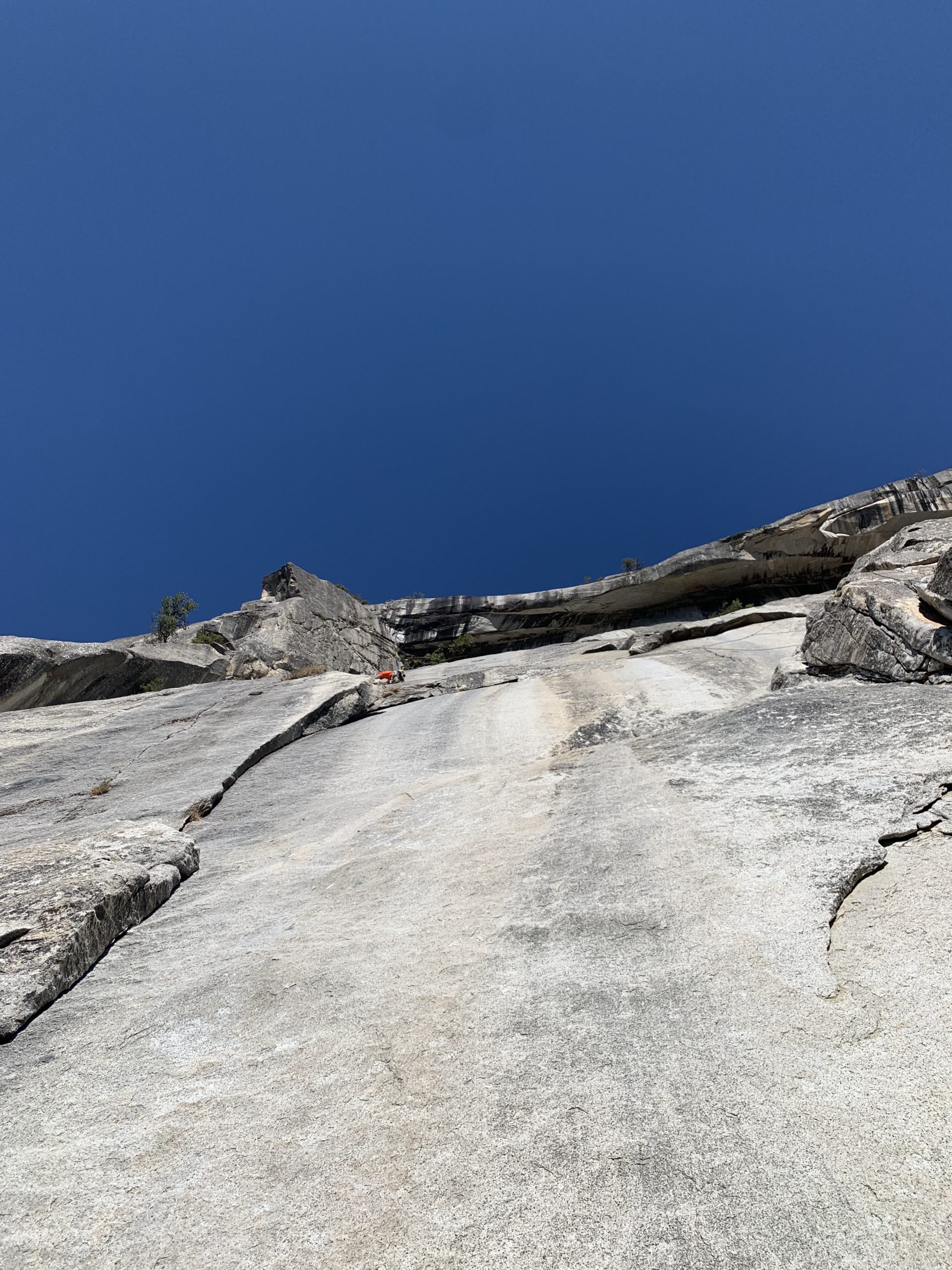
We said our final goodbyes to the Valley and climbed in the van to begin the long drive home. I am so thankful that everything came together to create the perfect first climbing trip to Yosemite. We climbed close to 70 guidebook pitches over the week, almost all of them word-class, and I was able to check off the major climbing goal of climbing The Nose. More importantly, this trip helped re-calibrate my view of Yosemite. No longer is it some intangible destination with impossibly hard climbs. Instead it is a place I hope to return to in years to come, better prepared and with even bigger goals.
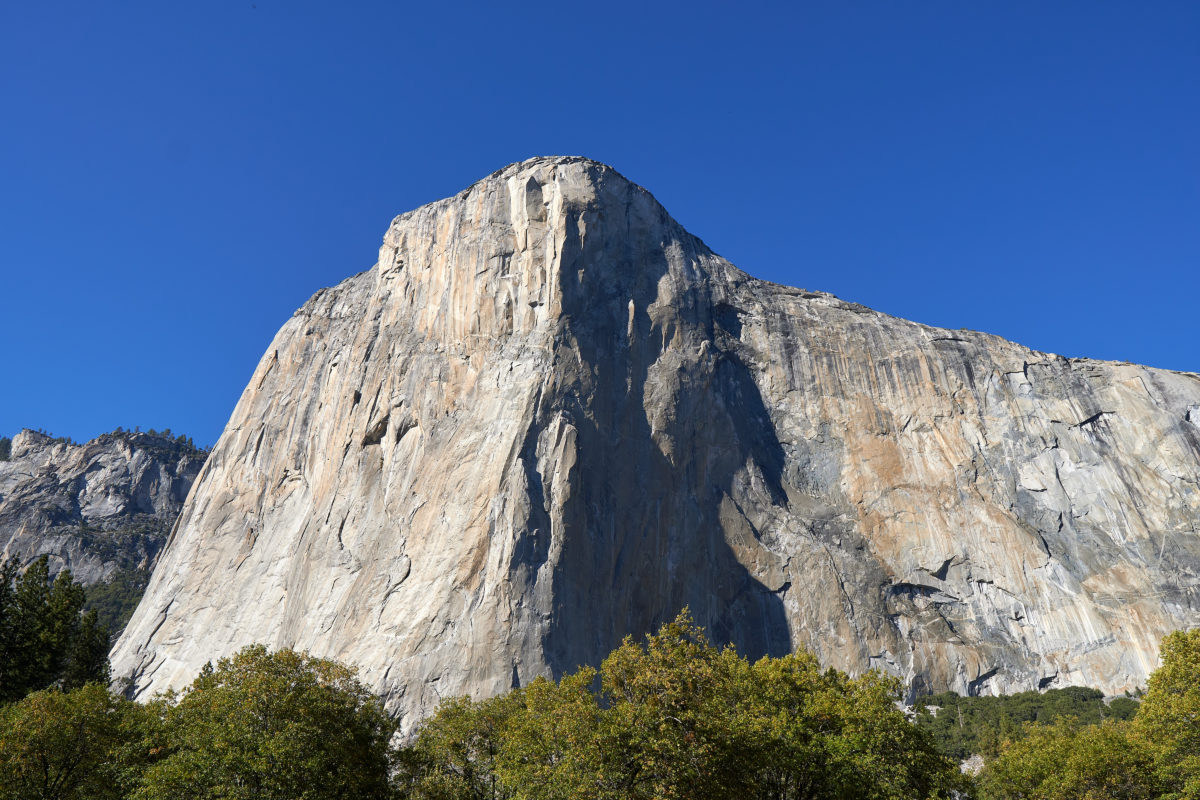
Leave a Reply